- Manuals
- Brands
- Cadillac Manuals
- Automobile Electronics
- Escalade 2016
Manuals and User Guides for Cadillac Escalade 2016. We have 4 Cadillac Escalade 2016 manuals available for free PDF download: Owner’s Manual, Manual, Convenience/Personalization Manual
Cadillac Escalade 2016 Owner’s Manual (397 pages)
Brand: Cadillac
|
Category: Automobile
|
Size: 5.76 MB
Table of Contents
-
Table of Contents
2
-
Introduction
3
-
Using this Manual
3
-
-
-
In Brief 5
6
-
In Brief
7
-
Instrument Panel
8
-
Instrument Panel
7
-
-
Initial Drive Information
9
-
Remote Keyless Entry (RKE)
9
-
System
9
-
-
Remote Vehicle Start
10
-
Door Locks
10
-
Liftgate
11
-
Windows
11
-
Seat Adjustment
12
-
Memory Features
14
-
Second Row Seats
14
-
Third Row Seats
14
-
Heated and Cooled Front
14
-
Seats
14
-
-
Head Restraint Adjustment
14
-
Safety Belts
15
-
Mirror Adjustment
15
-
Passenger Sensing System
15
-
Steering Wheel Adjustment
16
-
Interior Lighting
17
-
Throttle and Brake Pedal
17
-
Adjustment
17
-
-
Exterior Lighting
18
-
Windshield Wiper/Washer
18
-
Climate Controls
19
-
Four-Wheel Drive
20
-
Transmission
20
-
Cruise Control
21
-
Infotainment System
21
-
Steering Wheel Controls
21
-
-
Vehicle Features
21
-
Driver Information
22
-
Center (DIC)
22
-
-
Forward Collision Alert (FCA)
22
-
System
22
-
-
Front Automatic Braking (FAB)
22
-
Lane Keep Assist (LKA)
23
-
Lane Change Alert (LCA)
23
-
Surround Vision
23
-
Rear Vision Camera (RVC)
23
-
Rear Cross Traffic Alert (RCTA)
23
-
System
23
-
-
Parking Assist
24
-
Rear Automatic Braking (RAB)
24
-
System
24
-
-
Power Outlets
24
-
Universal Remote System
24
-
Sunroof
25
-
-
-
Performance and Maintenance
26
-
Traction Control/Electronic
26
-
Stability Control
26
-
-
Tire Pressure Monitor
26
-
Engine Oil Life System
26
-
Driving for Better Fuel
27
-
Economy
27
-
-
Roadside Service
27
-
-
-
Keys, Doors, and
28
-
Keys and Locks
28
-
Keys, Doors, and Windows
28
-
Keys
28
-
Remote Keyless Entry (RKE)
29
-
System
29
-
-
Remote Keyless Entry (RKE) System Operation
29
-
Remote Vehicle Start
36
-
Door Locks
37
-
Power Door Locks
38
-
Delayed Locking
38
-
Automatic Door Locks
39
-
Lockout Protection
39
-
Safety Locks
39
-
-
Doors
40
-
Liftgate
40
-
Power Assist Steps
44
-
Vehicle Security
45
-
Vehicle Alarm System
45
-
Immobilizer
47
-
Immobilizer Operation
47
-
-
Exterior Mirrors
48
-
Convex Mirrors
48
-
-
Power Mirrors
48
-
Folding Mirrors
49
-
Heated Mirrors
49
-
Reverse Tilt Mirrors
49
-
Interior Rearview Mirrors
50
-
Automatic Dimming Rearview Mirror
50
-
Child-View Mirror
50
-
Windows
50
-
Power Windows
51
-
Sun Visors
53
-
Sunroof
53
-
-
-
Vehicle Security
45
-
Interior Mirrors
50
-
-
Restraints
55
-
Seats and
78
-
Restraints
106
-
Roof
53
-
Seats and Restraints
55
-
Head Restraints
56
-
Front Seats
57
-
Power Seat Adjustment
57
-
Lumbar Adjustment
59
-
Reclining Seatbacks
59
-
Memory Seats
60
-
Massage
61
-
Heated and Cooled Front
62
-
Seats
62
-
-
-
Rear Seats
63
-
Heated Rear Seats
63
-
Second Row Seats
64
-
Third Row Seats
68
-
-
Safety Belts
70
-
How to Wear Safety Belts
71
-
Properly
71
-
-
Lap-Shoulder Belt
72
-
Safety Belt Use During
77
-
Pregnancy
77
-
-
Safety Belt Extender
77
-
Safety System Check
78
-
-
Safety Belt Care
78
-
Replacing Safety Belt System Parts after a Crash
78
-
Airbag System
79
-
Where Are the Airbags
80
-
When Should an Airbag
82
-
Inflate
82
-
-
What Makes an Airbag
83
-
Inflate
83
-
-
How Does an Airbag
83
-
Restrain
83
-
-
What will You See after an Airbag Inflates
84
-
Passenger Sensing System
85
-
Servicing the Airbag-Equipped
89
-
Vehicle
89
-
-
Adding Equipment to the Airbag-Equipped Vehicle
89
-
Parts after a Crash
90
-
Airbag System Check
90
-
Replacing Airbag System Parts
90
-
After a Crash
90
-
-
Child Restraints
91
-
Older Children
91
-
Infants and Young Children
93
-
Child Restraint Systems
95
-
Where to Put the Restraint
97
-
Lower Anchors and Tethers for Children (LATCH System)
98
-
Replacing LATCH System Parts after a Crash
105
-
Securing Child Restraints
106
-
(Rear Seat)
106
-
Securing Child Restraints (Front Passenger Seat)
108
-
-
-
Head Restraints
56
-
Airbag System
79
-
Child Restraints
91
-
-
-
Storage
111
-
Storage Compartments
111
-
Storage
111
-
Storage Compartments
111
-
Instrument Panel Storage
111
-
Glove Box
111
-
Cupholders
112
-
Sunglasses Storage
112
-
Armrest Storage
112
-
Rear Storage
112
-
Center Console Storage
113
-
Additional Storage Features
113
-
Cargo Cover
113
-
-
Roof Rack System
114
-
-
-
Instruments and
116
-
Instruments and Controls
116
-
Heated Steering Wheel
117
-
Steering Wheel Adjustment
117
-
Steering Wheel Controls
117
-
Horn
118
-
Windshield Wiper/Washer
118
-
Compass
120
-
Rear Window Wiper
120
-
Washer
120
-
Clock
121
-
Power Outlets
122
-
Wireless Charging
123
-
Cigarette Lighter
124
-
Ashtrays
125
-
Warning Lights, Gauges, and Indicators
125
-
Instrument Cluster
126
-
Speedometer
128
-
Odometer
128
-
Trip Odometer
128
-
Tachometer
129
-
Engine Coolant Temperature Gauge
129
-
Fuel Gauge
129
-
Gauge
129
-
-
Safety Belt Reminders
130
-
Airbag Readiness Light
131
-
Passenger Airbag Status
131
-
Indicator
131
-
-
Charging System Light
132
-
Malfunction Indicator Lamp (Check Engine Light)
132
-
Brake System Warning
134
-
Light
134
-
-
Electric Parking Brake
135
-
Light
135
-
-
Service Electric Parking Brake
135
-
Antilock Brake System (ABS)
135
-
Warning Light
135
-
-
Tow/Haul Mode Light
136
-
Lane Keep Assist (LKA)
136
-
Light
136
-
-
Vehicle Ahead Indicator
136
-
Traction off Light
136
-
OFF Light
137
-
Traction Control System (TCS)
137
-
Light
137
-
-
Engine Coolant Temperature
137
-
Warning Light
137
-
Stabilitrak off Light
137
-
-
Tire Pressure Light
138
-
Engine Oil Pressure Light
138
-
Low Fuel Warning Light
139
-
Security Light
139
-
High-Beam on Light
139
-
Lamps on Reminder
140
-
Cruise Control Light
140
-
Door Ajar Light
140
-
Information Displays
141
-
-
Driver Information
141
-
Center (DIC)
141
-
-
Head-Up Display (HUD)
143
-
Vehicle Messages
147
-
Messages
147
-
-
Brake System Messages
147
-
Compass Messages
148
-
Cruise Control Messages
148
-
Door Ajar Messages
149
-
Engine Cooling System
149
-
Messages
149
-
-
Engine Oil Messages
150
-
Engine Power Messages
150
-
Fuel System Messages
150
-
Key and Lock Messages
150
-
Lamp Messages
151
-
Object Detection System
151
-
Messages
151
-
-
Ride Control System
154
-
Messages
154
-
-
Airbag System Messages
154
-
Safety Belt Messages
155
-
Security Messages
155
-
Service Vehicle Messages
155
-
Steering System
155
-
Messages
155
-
-
Starting the Vehicle
155
-
Tire Messages
155
-
Transmission Messages
156
-
Vehicle Reminder
157
-
Messages
157
-
-
Vehicle Speed Messages
157
-
Washer Fluid Messages
158
-
Window Messages
158
-
Vehicle Personalization
158
-
-
Universal Remote System
165
-
Programming
165
-
Universal Remote System
167
-
Operation
167
-
-
-
-
-
Lighting
169
-
Exterior Lighting
169
-
Lighting
169
-
Exterior Lamp Controls
169
-
Exterior Lamps off
171
-
Reminder
171
-
-
Headlamp High/Low-Beam
171
-
Changer
171
-
-
Flash-To-Pass
171
-
Daytime Running
171
-
Lamps (DRL)
171
-
-
Automatic Headlamp
172
-
System
172
-
-
Hazard Warning Flashers
173
-
Turn and Lane-Change
173
-
Signals
173
-
-
Cornering Lamps
174
-
-
Interior Lighting
174
-
Instrument Panel Illumination
174
-
Control
174
-
-
Dome Lamps
175
-
Reading Lamps
175
-
-
Lighting Features
176
-
Entry Lighting
176
-
Exit Lighting
176
-
Battery Load Management
176
-
Battery Power Protection
177
-
-
-
Infotainment System
178
-
Climate Controls
179
-
Climate Control Systems
179
-
Dual Automatic Climate Control System
179
-
Rear Climate Control System
183
-
Air Vents
185
-
Passenger Compartment Air Filter
186
-
-
-
Advertisement
Cadillac Escalade 2016 Owner’s Manual (361 pages)
Brand: Cadillac
|
Category: Automobile
|
Size: 6.71 MB
Table of Contents
-
Owner Manual
2
-
Table of Contents
2
-
Introduction
3
-
Using this Manual
3
-
-
-
In Brief 5
6
-
Instrument Panel
7
-
Initial Drive Information
9
-
Remote Keyless Entry (RKE)
9
-
System
9
-
-
Remote Vehicle Start
10
-
Door Locks
10
-
Tailgate
11
-
Windows
11
-
Seat Adjustment
12
-
Memory Features
14
-
Second Row Seats
15
-
Third Row Seats
15
-
Heated and Cooled Front
15
-
Seats
15
-
-
Head Restraint Adjustment
15
-
Safety Belts
16
-
Passenger Sensing System
16
-
Mirror Adjustment
16
-
Steering Wheel Adjustment
17
-
Throttle and Brake Pedal
17
-
Adjustment
17
-
-
Interior Lighting
18
-
Exterior Lighting
18
-
Windscreen Wiper/Washer
19
-
Climate Controls
20
-
Transmission
20
-
Four-Wheel Drive
21
-
-
Vehicle Features
22
-
Steering Wheel Controls
22
-
Cruise Control
22
-
Driver Information
22
-
Centre (DIC)
22
-
-
Forward Collision Alert (FCA)
23
-
System
23
-
-
Front Automatic Braking (FAB)
23
-
Lane Keep Assist (LKA)
23
-
Lane Change Alert (LCA)
23
-
Surround Vision
23
-
Rear Vision Camera (RVC)
24
-
Rear Cross Traffic Alert (RCTA)
24
-
System
24
-
-
Parking Assist
24
-
Power Outlets
24
-
Universal Remote System
25
-
Sunroof
25
-
-
Performance and Maintenance
26
-
Traction Control/Electronic
26
-
Stability Control
26
-
-
Tyre Pressure Monitor
26
-
Engine Oil Life System
27
-
Driving for Better Fuel
27
-
Economy
27
-
-
-
-
Keys, Doors, and Windows 27 Keys, Doors, and Exterior Mirrors Keys and Locks
28
-
Keys and Locks
28
-
Keys, Doors, and Windows
28
-
Keys
28
-
Remote Keyless Entry (RKE)
29
-
System
29
-
Remote Keyless Entry (RKE) System Operation
29
-
Remote Vehicle Start
34
-
Door Locks
35
-
Power Door Locks
37
-
Delayed Locking
37
-
Automatic Door Locks
37
-
Lockout Protection
37
-
Safety Locks
38
-
Doors
38
-
Tailgate
38
-
Power Assist Steps
42
-
Vehicle Security
43
-
Vehicle Alarm System
43
-
Anti-Theft Locking System
45
-
Immobiliser
45
-
Immobiliser Operation
45
-
Exterior Mirrors
46
-
Convex Mirrors
46
-
Power Mirrors
46
-
Folding Mirrors
47
-
Heated Mirrors
48
-
Reverse Tilt Mirrors
48
-
Interior Rearview Mirrors
48
-
Automatic Dimming Rearview Mirror
48
-
Child-View Mirror
48
-
Windows
49
-
Power Windows
49
-
Sun Visors
51
-
Sunroof
51
-
-
-
Vehicle Security
43
-
Exterior Mirrors
46
-
Interior Mirrors
48
-
Windows
49
-
Roof
51
-
-
52 Seats and Safety Belts Child Restraints
53
-
Seats and Restraints
53
-
Head Restraints
54
-
Front Seats
55
-
Power Seat Adjustment
55
-
Lumbar Adjustment
56
-
Reclining Seat Backrests
58
-
Memory Seats
59
-
Massage
60
-
Heated and Cooled Front
61
-
Seats
61
-
-
Rear Seats
62
-
Heated Rear Seats
62
-
Second Row Seats
63
-
Third Row Seats
67
-
-
Safety Belts
69
-
How to Wear Safety Belts
70
-
Properly
70
-
-
Lap-Shoulder Belt
71
-
Safety Belt Use During
76
-
Pregnancy
76
-
-
Safety System Check
76
-
Safety Belt Care
77
-
Replacing Safety Belt System Parts after a Crash
77
-
Airbag System
78
-
Where Are the Airbags
79
-
When Should an Airbag
81
-
Inflate
81
-
-
What Makes an Airbag
82
-
Inflate
82
-
-
How Does an Airbag
82
-
Restrain
82
-
-
What will You See after an Airbag Inflates
83
-
Passenger Sensing System
84
-
Servicing the Airbag-Equipped
88
-
Vehicle
88
-
-
Adding Equipment to the Airbag-Equipped Vehicle
88
-
Airbag System Check
89
-
Replacing Airbag System Parts
89
-
After a Crash
89
-
Parts after a Crash
89
-
-
Child Restraints
90
-
Older Children
90
-
Infants and Young Children
92
-
Child Restraint Systems
94
-
Where to Put the Restraint
95
-
ISOFIX Child Restraint
108
-
Systems
108
-
-
Securing Child Restraints (Front Passenger Seat)
109
-
Securing Child Restraints
109
-
(Rear Seat)
112
-
-
-
Head Restraints
54
-
Safety Belts
69
-
Airbag System
78
-
-
Storage 113 Storage Storage Instrument Panel Storage Compartments
114
-
Storage Compartments
114
-
Storage
114
-
Storage Compartments
114
-
Instrument Panel Storage
114
-
Glove Box
115
-
Cupholders
115
-
Sunglasses Storage
115
-
Armrest Storage
115
-
Rear Storage
116
-
Centre Console Storage
116
-
Additional Storage Features
117
-
Cargo Cover
117
-
Roof Rack System
118
-
-
-
Roof Rack System
118
-
-
Controls
119
-
Instruments and Controls
119
-
Steering Wheel Adjustment
120
-
Steering Wheel Controls
120
-
Heated Steering Wheel
120
-
Horn
121
-
Windscreen Wiper/Washer
121
-
Rear Window Wiper
123
-
Washer
123
-
-
Clock
123
-
Power Sockets
124
-
Wireless Charging
126
-
Cigarette Lighter
128
-
Ashtrays
128
-
-
Warning Lights, Gauges, and Indicators
128
-
Instrument Cluster
129
-
Speedometer
131
-
Mileometer
131
-
Trip Odometer
131
-
Rev Counter
132
-
Fuel Gauge
132
-
Engine Coolant Temperature
132
-
Gauge
132
-
-
-
Seat Belt Reminders
133
-
Airbag Readiness Light
133
-
Passenger Airbag Status
134
-
Indicator
134
-
-
Charging System Light
134
-
Malfunction Indicator Lamp (Check Engine Light)
135
-
Brake System Warning
137
-
Light
137
-
-
Electric Parking Brake
137
-
Electric Parking Brake Light
137
-
Service Electric Parking Brake
138
-
Light
138
-
-
Antilock Brake System (ABS)
138
-
Warning Light
138
-
-
Gear Shifting Light
138
-
Tow/Haul Mode Light
139
-
Lane Keep Assist (LKA)
139
-
Light
139
-
-
Vehicle Ahead Indicator
139
-
Traction off Light
139
-
Stabilitrak ® off Light
140
-
Traction Control System (TCS)
140
-
Light
140
-
-
Engine Coolant Temperature
140
-
Warning Light
140
-
-
Tyre Pressure Light
141
-
Engine Oil Pressure Light
141
-
Low Fuel Warning Light
142
-
Security Light
142
-
Main-Beam on Light
142
-
Lamps on Reminder
142
-
Cruise Control Light
143
-
Door Ajar Light
143
-
Information Displays
143
-
Driver Information
143
-
Centre (DIC)
143
-
-
Head-Up Display (HUD)
146
-
Vehicle Messages
149
-
Messages
149
-
-
Brake System Messages
150
-
Cruise Control Messages
150
-
Door Ajar Messages
151
-
Engine Cooling System
151
-
Messages
151
-
-
Engine Oil Messages
152
-
Engine Power Messages
152
-
Fuel System Messages
152
-
Key and Lock Messages
153
-
Lamp Messages
153
-
Object Detection System
153
-
Messages
153
-
-
Ride Control System
155
-
Messages
155
-
-
Airbag System Messages
156
-
Safety Belt Messages
156
-
Security Messages
156
-
Service Vehicle Messages
156
-
Steering System
157
-
Messages
157
-
-
Starting the Vehicle
157
-
Tyre Messages
157
-
Transmission Messages
158
-
Vehicle Reminder
159
-
Messages
159
-
-
Vehicle Speed Messages
159
-
Washer Fluid Messages
159
-
Window Messages
159
-
-
Vehicle Personalisation
159
-
Universal Remote System
167
-
Programming
167
-
Universal Remote System
169
-
Operation
169
-
-
-
-
-
Lighting 169 Lighting Exterior Lighting
170
-
Exterior Lighting
170
-
Lighting
170
-
Exterior Lamp Controls
170
-
Exterior Lamps off
172
-
Reminder
172
-
-
Headlamp Main/Dipped-Beam
172
-
Changer
172
-
-
Flash-To-Pass
172
-
Daytime Running
172
-
Lamps (DRL)
172
-
-
Automatic Headlamp
173
-
System
173
-
-
Hazard Lights
174
-
Turn and Lane-Change
174
-
Signals
174
-
-
Cornering Lights
175
-
-
Interior Lighting
175
-
Instrument Panel Illumination
175
-
Control
175
-
-
Dome Lamps
175
-
Reading Lamps
176
-
-
Lighting Features
176
-
Entry Lighting
176
-
Exit Lighting
177
-
Battery Load Management
177
-
Battery Power Protection
177
-
-
-
Infotainment System
178
-
Climate Controls
179
-
Rear Climate Control System
184
-
Passenger Compartment Air Filter
186
-
-
-
Cadillac Escalade 2016 Manual (357 pages)
Brand: Cadillac
|
Category: Automobile
|
Size: 3.66 MB
Table of Contents
-
Table of Contents
2
-
Introduction
3
-
-
In Brief 5
6
-
Instrument Panel
7
-
Initial Drive Information
9
-
Remote Keyless Entry (RKE)
9
-
System
9
-
-
Remote Vehicle Start
10
-
Door Locks
10
-
Liftgate
11
-
Windows
11
-
Seat Adjustment
12
-
Memory Features
14
-
Second Row Seats
15
-
Third Row Seats
15
-
Heated and Cooled Front
15
-
Seats
15
-
-
Head Restraint Adjustment
15
-
Safety Belts
16
-
Passenger Sensing System
16
-
Mirror Adjustment
16
-
Steering Wheel Adjustment
17
-
Throttle and Brake Pedal
17
-
Adjustment
17
-
-
Interior Lighting
18
-
Exterior Lighting
18
-
Windshield Wiper/Washer
19
-
Climate Controls
20
-
Transmission
20
-
Four-Wheel Drive
21
-
-
-
Vehicle Features
22
-
Infotainment System
22
-
Steering Wheel Controls
22
-
Cruise Control
22
-
Driver Information
22
-
Center (DIC)
22
-
-
Forward Collision Alert (FCA)
23
-
System
23
-
-
Front Automatic Braking (FAB)
23
-
Lane Keep Assist (LKA)
23
-
Lane Change Alert (LCA)
24
-
Surround Vision
24
-
Rear Vision Camera (RVC)
24
-
Rear Cross Traffic Alert (RCTA)
24
-
System
24
-
-
Parking Assist
24
-
Rear Automatic Braking (RAB)
25
-
System
25
-
-
Power Outlets
25
-
Universal Remote System
25
-
Sunroof
25
-
-
Performance and Maintenance
26
-
Traction Control/Electronic
26
-
Stability Control
26
-
-
Tire Pressure Monitor
27
-
Engine Oil Life System
27
-
-
Driving for Better Fuel
28
-
Economy
28
-
-
-
Keys, Doors, and
29
-
Keys and Locks
29
-
Keys, Doors, and Windows
29
-
Keys
29
-
Remote Keyless Entry (RKE)
30
-
System
30
-
Remote Keyless Entry (RKE) System Operation
30
-
Remote Vehicle Start
35
-
Door Locks
36
-
Power Door Locks
37
-
Delayed Locking
38
-
Automatic Door Locks
38
-
Lockout Protection
38
-
Safety Locks
38
-
-
-
-
Doors
39
-
Liftgate
39
-
Power Assist Steps
43
-
-
Vehicle Security
44
-
Vehicle Alarm System
44
-
Immobilizer Operation
45
-
-
Exterior Mirrors
46
-
Convex Mirrors
46
-
Power Mirrors
46
-
Folding Mirrors
47
-
Heated Mirrors
48
-
Blind Spot Mirrors
48
-
Reverse Tilt Mirrors
49
-
-
Interior Mirrors
49
-
Interior Rearview Mirrors
49
-
Automatic Dimming Rearview Mirror
49
-
Child-View Mirror
49
-
-
Windows
50
-
Power Windows
50
-
Sun Visors
52
-
-
Roof
52
-
Sunroof
52
-
-
-
Seats and Restraints 53
54
-
Head Restraints
55
-
Front Seats
56
-
Power Seat Adjustment
56
-
Lumbar Adjustment
57
-
Reclining Seatbacks
58
-
Memory Seats
59
-
Heated and Cooled Front
61
-
Seats
61
-
-
Massage
61
-
-
Rear Seats
63
-
Heated Rear Seats
63
-
Second Row Seats
63
-
Third Row Seats
68
-
-
Safety Belts
70
-
How to Wear Safety Belts
71
-
Properly
71
-
-
Lap-Shoulder Belt
72
-
Safety Belt Use During
76
-
Pregnancy
76
-
-
Safety System Check
77
-
Safety Belt Care
77
-
Replacing Safety Belt System Parts after a Crash
77
-
-
Airbag System
78
-
Where Are the Airbags
80
-
When Should an Airbag
81
-
Inflate
81
-
-
How Does an Airbag
82
-
Restrain
82
-
-
What Makes an Airbag
82
-
Inflate
82
-
-
What will You See after an Airbag Inflates
83
-
Passenger Sensing System
84
-
Servicing the Airbag-Equipped
88
-
Vehicle
88
-
-
Adding Equipment to the Airbag-Equipped Vehicle
89
-
Airbag System Check
89
-
-
Child Restraints
90
-
Older Children
90
-
Replacing Airbag System Parts
90
-
After a Crash
90
-
-
Infants and Young Children
92
-
Child Restraint Systems
94
-
Where to Put the Restraint
95
-
Lower Anchors and Tethers for Children (LATCH System)
97
-
-
Replacing LATCH System Parts after a Crash
104
-
(Rear Seat)
105
-
-
Securing Child Restraints
105
-
Securing Child Restraints (Front Passenger Seat)
107
-
-
Storage
110
-
Storage Compartments
110
-
Storage
110
-
Storage Compartments
110
-
Instrument Panel Storage
110
-
Glove Box
110
-
Sunglasses Storage
111
-
Armrest Storage
111
-
Rear Storage
111
-
Center Console Storage
111
-
Additional Storage Features
112
-
Cargo Cover
112
-
Roof Rack System
113
-
-
-
Roof Rack System
113
-
-
Controls
115
-
Instruments and Controls
115
-
Steering Wheel Adjustment
116
-
Steering Wheel Controls
116
-
Heated Steering Wheel
116
-
Horn
117
-
Windshield Wiper/Washer
117
-
Rear Window Wiper
119
-
Washer
119
-
Compass
119
-
Clock
120
-
Power Outlets
121
-
Wireless Charging
122
-
Cigarette Lighter
123
-
Ashtrays
124
-
-
Warning Lights, Gauges, and Indicators
124
-
Instrument Cluster
125
-
Odometer
127
-
Speedometer
127
-
Trip Odometer
127
-
-
Engine Coolant Temperature Gauge
128
-
Fuel Gauge
128
-
Tachometer
128
-
-
Safety Belt Reminders
129
-
Airbag Readiness Light
130
-
Passenger Airbag Status
130
-
Indicator
130
-
-
Charging System Light
131
-
Malfunction Indicator Lamp (Check Engine Light)
131
-
Brake System Warning
133
-
Light
133
-
-
Antilock Brake System (ABS)
134
-
Warning Light
134
-
-
Electric Parking Brake
134
-
Light
134
-
-
Service Electric Parking Brake
134
-
Traction off Light
135
-
Tow/Haul Mode Light
135
-
Vehicle Ahead Indicator
135
-
Lane Keep Assist (LKA)
135
-
Light
135
-
-
Engine Coolant Temperature
136
-
Warning Light
136
-
Stabilitrak ® off Light
136
-
-
Traction Control System (Tcs)/Stabilitrak Light
136
-
Tire Pressure Light
137
-
High-Beam on Light
138
-
-
Engine Oil Pressure Light
137
-
Low Fuel Warning Light
138
-
Security Light
138
-
Cruise Control Light
139
-
Door Ajar Light
139
-
Lamps on Reminder
139
-
-
Information Displays Driver Information
140
-
Center (DIC)
140
-
Head-Up Display (HUD)
142
-
Brake System Messages
146
-
Vehicle Messages
146
-
Messages
146
-
-
Compass Messages
147
-
Cruise Control Messages
147
-
Door Ajar Messages
148
-
Engine Cooling System
148
-
Messages
148
-
-
Engine Oil Messages
149
-
Engine Power Messages
149
-
Fuel System Messages
149
-
Key and Lock Messages
149
-
Lamp Messages
150
-
Object Detection System
150
-
Messages
150
-
-
Airbag System Messages
153
-
Ride Control System
153
-
Messages
153
-
-
Safety Belt Messages
154
-
Security Messages
154
-
Service Vehicle Messages
154
-
Steering System
154
-
Messages
154
-
-
Starting the Vehicle
154
-
Tire Messages
154
-
Transmission Messages
155
-
Vehicle Reminder
156
-
Messages
156
-
-
Vehicle Speed Messages
156
-
Washer Fluid Messages
156
-
Window Messages
156
-
-
-
Vehicle Personalization
157
-
Universal Remote System
164
-
Programming
164
-
Operation
166
-
-
-
166 Lighting Lighting Exterior Lighting
167
-
Exterior Lighting
167
-
Lighting
167
-
Exterior Lamp Controls
167
-
Exterior Lamps off
169
-
Reminder
169
-
-
Headlamp High/Low-Beam
169
-
Changer
169
-
-
Flash-To-Pass
169
-
Daytime Running
169
-
Lamps (DRL)
169
-
-
Automatic Headlamp
170
-
System
170
-
-
Hazard Warning Flashers
171
-
Turn and Lane-Change
171
-
Signals
171
-
-
Cornering Lamps
172
-
-
Interior Lighting
172
-
Instrument Panel Illumination Control
172
-
Dome Lamps
173
-
Reading Lamps
173
-
-
Lighting Features
174
-
Entry Lighting
174
-
Exit Lighting
174
-
Battery Load Management
174
-
Battery Power Protection
175
-
-
-
Infotainment System
176
-
Climate Controls
177
-
Climate Control Systems
177
-
Dual Automatic Climate Control System
177
-
Rear Climate Control System
181
-
Air Vents
183
-
Passenger Compartment Air Filter
184
-
-
-
Advertisement
Cadillac Escalade 2016 Convenience/Personalization Manual (21 pages)
Brand: Cadillac
|
Category: Automobile Electronics
|
Size: 3.31 MB
Table of Contents
-
Instrument Panel
2
-
Keyless Access System
3
-
Pushbutton Start
4
-
Steering Wheel Controls
5
-
Instrument Cluster
6
-
Driver Information Center
7
-
Head-Up Display
7
-
Touch Screen and Controls
8
-
Voice Recognition
11
-
Bluetooth ® System
11
-
Wireless Charging
12
-
Vehicle Personalization
12
-
Windshield Wipers
13
-
Driver Assistance Systems
14
-
Automatic Transmission
15
-
Tire Pressure Monitor
16
-
Power Liftgate
17
-
Power Front Seats
18
-
Rear Seats
19
Advertisement
Related Products
-
Cadillac Escalade 2004 Escalade ESV
-
Cadillac Escalade 2018
-
Cadillac Escalade 2017
-
Cadillac Escalade 2020
-
Cadillac Escalade EXT
-
Cadillac Escalade ESV
-
Cadillac ESCALADE — BROCHURE 2011
-
Cadillac ESCALADE — BROCHURE 2009
-
CADILLAC ESCALADE EXT — DATASHEET 2011
-
Cadillac Escalade Two-mode Hybrid 2009
Cadillac Categories
Automobile
Car Navigation system
Car Receiver
Car Video System
Car Stereo System
More Cadillac Manuals
Посмотреть инструкция для Cadillac Escalade (2016) бесплатно. Руководство относится к категории автомобили, 1 человек(а) дали ему среднюю оценку 6.8. Руководство доступно на следующих языках: английский. У вас есть вопрос о Cadillac Escalade (2016) или вам нужна помощь? Задайте свой вопрос здесь
Не можете найти ответ на свой вопрос в руководстве? Вы можете найти ответ на свой вопрос ниже, в разделе часто задаваемых вопросов о Cadillac Escalade (2016).
Как перевести мили в километры?
Где я могу узнать идентификационный номер транспортного средства Cadillac?
Что такое идентификационный номер транспортного средства (VIN)?
Когда транспортному средству Cadillac требуется техническое обслуживание?
Когда следует заменять тормозную жидкость на Cadillac?
В чем разница между топливом E10 и E5?
Одна или несколько дверей не открываются изнутри. Что мне делать?
Автомобильный радиоприемник не включается, что делать?
Инструкция Cadillac Escalade (2016) доступно в русский?
Не нашли свой вопрос? Задайте свой вопрос здесь


Contents
Introduction . . . . . . . . . . . . . . . . . . . . . . 2
In Brief . . . . . . . . . . . . . . . . . . . . . . . . . . . 5
Keys, Doors, and Windows . . . . . 27
Seats and Restraints . . . . . . . . . . . 54
Storage . . . . . . . . . . . . . . . . . . . . . . . 110
Instruments and Controls . . . . . . 115
Lighting . . . . . . . . . . . . . . . . . . . . . . . 168
Infotainment System . . . . . . . . . . 177
Climate Controls . . . . . . . . . . . . . . 178
Driving and Operating . . . . . . . . . 186
Vehicle Care . . . . . . . . . . . . . . . . . . 264
Service and Maintenance . . . . . 346
Technical Data . . . . . . . . . . . . . . . . 360
Customer Information . . . . . . . . . 363
Reporting Safety Defects . . . . . . 373
OnStar . . . . . . . . . . . . . . . . . . . . . . . . 376
Index . . . . . . . . . . . . . . . . . . . . 386
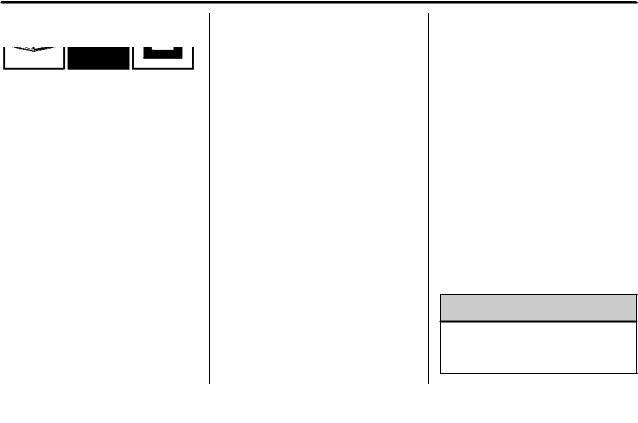
2Introduction
Introduction
The names, logos, emblems, slogans, vehicle model names, and vehicle body designs appearing in this manual including, but not limited to, GM, the GM logo, CADILLAC, the CADILLAC Emblem, and ESCALADE are trademarks and/or service marks of General Motors LLC, its subsidiaries, affiliates,
or licensors.
For vehicles first sold in Canada, substitute the name “General Motors of Canada Limited” for Cadillac Motor Division wherever it appears in this manual.
This manual describes features that may or may not be on the vehicle because of optional equipment that
Litho in U.S.A.
Part No. 23133525 A First Printing
was not purchased on the vehicle, model variants, country specifications, features/applications that may not be available in your region, or changes subsequent to the printing of this owner manual.
Refer to the purchase documentation relating to your specific vehicle to confirm the features.
Keep this manual in the vehicle for quick reference.
Canadian Vehicle Owners
Propriétaires Canadiens
A French language manual can be obtained from your dealer, at www.helminc.com, or from:
On peut obtenir un exemplaire de ce guide en français auprès du concessionnaire ou à l’adresse savant:
Helm, Incorporated
Attention: Customer Service
47911 Halyard Drive
Plymouth, MI 48170
Using this Manual
To quickly locate information about the vehicle, use the Index in the back of the manual. It is an alphabetical list of what is in the manual and the page number where it can be found.
Danger, Warning, and
Caution
Warning messages found on vehicle labels and in this manual describe hazards and what to do to avoid or reduce them.
{Danger
Danger indicates a hazard with a high level of risk which will result in serious injury or death.
© 2015 General Motors LLC. All Rights Reserved.

Introduction 3
{Warning
Warning indicates a hazard that could result in injury or death.
Caution
Caution indicates a hazard that could result in property or vehicle damage.
A circle with a slash through it is a safety symbol which means “Do Not,” “Do not do this,” or “Do not let this happen.”
Symbols
The vehicle has components and labels that use symbols instead of text. Symbols are shown along with the text describing the operation or information relating to a specific component, control, message, gauge, or indicator.
M : Shown when the owner manual has additional instructions or information.
* : Shown when the service manual has additional instructions or information.
0 : Shown when there is more information on another page — “see page.”
Vehicle Symbol Chart
Here are some additional symbols that may be found on the vehicle and what they mean. For more information on the symbol, refer to the Index.
0 : Adjustable Pedals
9 : Airbag Readiness Light
! : Antilock Brake System (ABS)
g : Audio Steering Wheel Controls or OnStar® (if equipped)
$ : Brake System Warning Light
» : Charging System
I : Cruise Control
` : Do Not Puncture
^ : Do Not Service
B : Engine Coolant Temperature
O : Exterior Lamps
_ : Flame/Fire Prohibited
. : Fuel Gauge
+ : Fuses
3 : Headlamp High/Low-Beam Changer
( : Heated Steering Wheel
j : LATCH System Child Restraints
* : Malfunction Indicator Lamp
: : Oil Pressure
g : Outside Power Foldaway Mirrors
O : Power
/ : Remote Vehicle Start

4Introduction
> : Safety Belt Reminders
7 : Tire Pressure Monitor
_ : Tow/Haul Mode
d : Traction Control/StabiliTrak®
a : Under Pressure
M : Windshield Washer Fluid

In Brief
Instrument Panel
Instrument Panel . . . . . . . . . . . . . . . . 6
Initial Drive Information
Initial Drive Information . . . . . . . . . . 8
Remote Keyless Entry (RKE)
System . . . . . . . . . . . . . . . . . . . . . . . . 8
Remote Vehicle Start . . . . . . . . . . . 9
Door Locks . . . . . . . . . . . . . . . . . . . . . 9
Liftgate . . . . . . . . . . . . . . . . . . . . . . . . 10
Windows . . . . . . . . . . . . . . . . . . . . . . . 10
Seat Adjustment . . . . . . . . . . . . . . . 11
Memory Features . . . . . . . . . . . . . . 13
Second Row Seats . . . . . . . . . . . . 13
Third Row Seats . . . . . . . . . . . . . . . 13
Heated and Cooled Front
Seats . . . . . . . . . . . . . . . . . . . . . . . . . 13
Head Restraint Adjustment . . . . 13
Safety Belts . . . . . . . . . . . . . . . . . . . . 14
Passenger Sensing System . . . 14
Mirror Adjustment . . . . . . . . . . . . . . 14
Steering Wheel Adjustment . . . . 15
Throttle and Brake Pedal
Adjustment . . . . . . . . . . . . . . . . . . . 16
Interior Lighting . . . . . . . . . . . . . . . . 16
Exterior Lighting . . . . . . . . . . . . . . . 17
Windshield Wiper/Washer . . . . . . 17
Climate Controls . . . . . . . . . . . . . . . 18
Transmission . . . . . . . . . . . . . . . . . . 19
Four-Wheel Drive . . . . . . . . . . . . . . 19
Vehicle Features
Infotainment System . . . . . . . . . . . 20
Steering Wheel Controls . . . . . . . 20
Cruise Control . . . . . . . . . . . . . . . . . 20
Driver Information
Center (DIC) . . . . . . . . . . . . . . . . . 21
Forward Collision Alert (FCA)
System . . . . . . . . . . . . . . . . . . . . . . . 21
Front Automatic Braking (FAB)
System . . . . . . . . . . . . . . . . . . . . . . . 21
Lane Keep Assist (LKA) . . . . . . . 22
Lane Change Alert (LCA) . . . . . . 22
Surround Vision . . . . . . . . . . . . . . . 22
Rear Vision Camera (RVC) . . . . 22
Rear Cross Traffic Alert (RCTA)
System . . . . . . . . . . . . . . . . . . . . . . . 22
Parking Assist . . . . . . . . . . . . . . . . . 23
Rear Automatic Braking (RAB)
System . . . . . . . . . . . . . . . . . . . . . . . 23
Power Outlets . . . . . . . . . . . . . . . . . 23
Universal Remote System . . . . . 23
Sunroof . . . . . . . . . . . . . . . . . . . . . . . . 24
Performance and Maintenance
Traction Control/Electronic Stability Control . . . . . . . . . . . . . . 25
Tire Pressure Monitor . . . . . . . . . . 25 Engine Oil Life System . . . . . . . . 25 Driving for Better Fuel
Economy . . . . . . . . . . . . . . . . . . . . . 26 Roadside Service . . . . . . . . . . . . . . 26
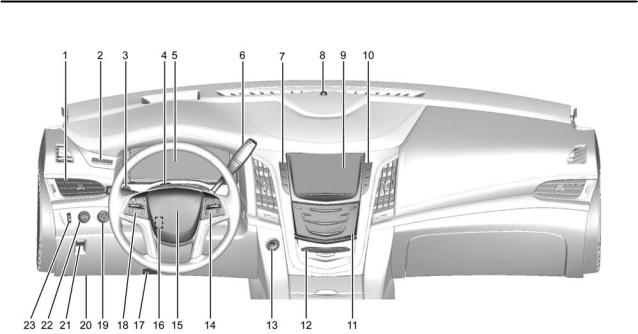
6In Brief
Instrument Panel
English Version Shown, Metric Similar

1.Air Vents 0 184.
2.Head-Up Display (HUD) 0 142
(If Equipped).
3.Turn Signal Lever. See Turn and Lane-Change Signals 0 172.
Windshield Wiper/Washer 0 117.
Rear Window Wiper/Washer 0 119.
4.Hazard Warning Flashers 0 172.
5.Instrument Cluster 0 125.
6.Shift Lever. See Automatic Transmission 0 211.
Tow/Haul Mode Selector Button. See Tow/Haul Mode 0 216.
Range Selection Mode Buttons (If Equipped). See Manual Mode 0 213.
7.Power Assist Steps 0 43 (If Equipped).
Pedal Adjust Switch (If Equipped). See Adjustable Throttle and Brake Pedal 0 203.
Magnetic Ride Control Button.
See Magnetic Ride Control
0 226.
8.Light Sensor. See Automatic Headlamp System 0 171.
9.Infotainment 0 177.
10.Glove Box Button. See Glove Box 0 110.
Parking Assist Button. See
Assistance Systems for Parking or Backing 0 237.
Lane Keep Assist (LKA) 0 248
(If Equipped).
Traction Control/Electronic Stability Control 0 224.
11.Dual Automatic Climate Control System 0 178.
Instrument Panel Storage 0 110.
12.CD Player. See the infotainment manual.
13.ENGINE START/STOP Button. See Ignition Positions 0 203.
14.Steering Wheel Controls 0 116.
Driver Information Center (DIC) Controls. See Driver Information Center (DIC) 0 140.
15.Horn 0 117.
16.Steering Wheel Adjustment 0 116.
17.Hood Release. See Hood
0 266.
18.Cruise Control 0 227 (If Equipped).
Adaptive Cruise Control 0 229
(If Equipped).
Forward Collision Alert (FCA) System 0 242 (If Equipped).
Heated Steering Wheel 0 116
(If Equipped).
Phone Button. See the infotainment manual.
19.Automatic Transfer Case Knob (If Equipped). See Four-Wheel Drive 0 217.
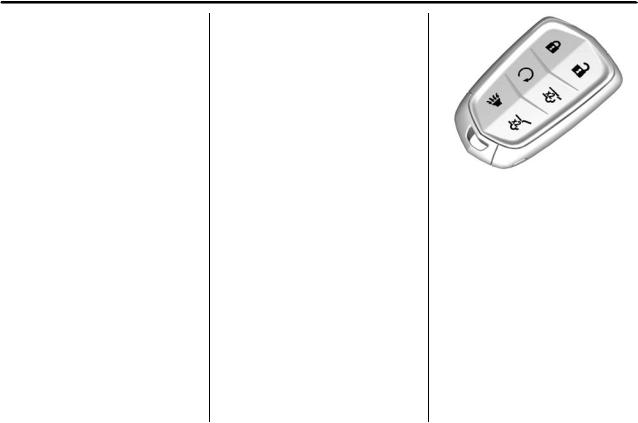
8In Brief
20.Data Link Connector (DLC) (Out of View). See Malfunction Indicator Lamp (Check Engine Light) 0 131.
21.Electric Parking Brake 0 221 (If Equipped).
22.Exterior Lamp Controls 0 168.
23.Instrument Panel Illumination Control 0 173.
Initial Drive
Information
This section provides a brief overview about some of the important features that may or may not be on your specific vehicle.
For more detailed information, refer to each of the features which can be found later in this owner manual.
Remote Keyless Entry
(RKE) System
The RKE transmitter is used to remotely lock and unlock the doors from up to 60 m (197 ft) away from the vehicle.
K : Press to unlock the driver door. Press K again within three seconds to unlock all remaining doors.
Q : Press to lock all doors.
Lock and unlock feedback can be personalized. See Vehicle Personalization 0 157.
b : Press twice to open or close the liftgate. Press once to stop the liftgate from moving.
c : Press twice to open the liftglass.
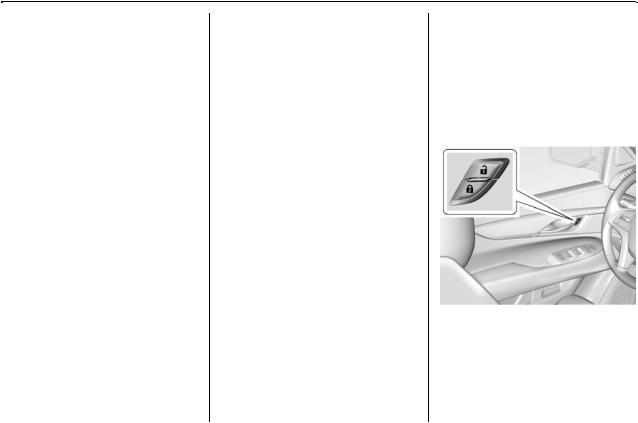
7 : Press and release to initiate vehicle locate. The turn signal lamps flash and the horn sound three times.
Press 7 and hold for more than three seconds to sound the panic alarm.
Press 7 again to cancel the panic alarm.
See Keys 0 27 and Remote Keyless Entry (RKE) System 0 28.
Remote Vehicle Start
If equipped, the engine can be started from outside of the vehicle.
Starting the Vehicle
1.Press and release Q on the RKE transmitter.
2.Immediately, press and hold / for at least four seconds or until the turn signal lamps flash.
3.Start the vehicle normally after entering.
When the vehicle starts, the parking lamps will turn on.
Remote start can be extended.
Canceling a Remote Start
To cancel a remote start, do one of the following:
.Press and hold / until the parking lamps turn off.
.Turn on the hazard warning flashers.
. Turn the vehicle on and then off.
See Remote Vehicle Start 0 35.
Door Locks
To lock or unlock the doors from inside the vehicle:
.Press Q or K on a power door lock switch.
.Push down the manual lock knob on the driver door to lock all doors. Push down the lock knob on a passenger door to lock that door only.
.Pull the door handle once to unlock that door. Pull the handle again to unlatch it.
To lock or unlock the doors from outside the vehicle press Q or K on the RKE transmitter or use the key in the front doors. The key cylinder is covered by a cap. See Door Locks 0 36. See Remote Keyless Entry (RKE) System Operation 0 28.
Power Door Locks
Q : Press to lock the doors.
K : Press to unlock the doors.
See Door Locks 0 36.
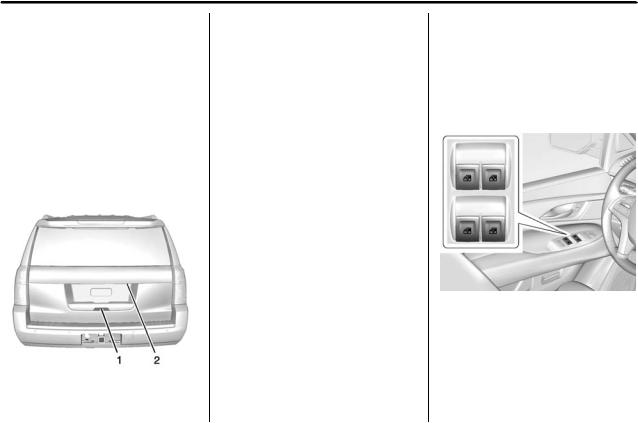
10 In Brief
Keyless Access
The RKE transmitter must be within 1 m (3 ft) of the door being opened. Pressing the button on the driver door handle will unlock the driver door. If the handle button is pressed again within five seconds, the passenger doors and liftgate will unlock. See “Keyless Access Operation” in Remote Keyless Entry (RKE) System Operation 0 28.
Liftgate
To open the liftgate, press K on the
power door lock switch or press K on the Remote Keyless Entry (RKE)
transmitter twice to unlock all doors. Press the touch pad (1) on the underside of the liftgate handle and lift up. See Remote Keyless Entry (RKE) System Operation 0 28.
Use the pull cup to lower and close the liftgate. Do not press the touch pad while closing the liftgate. This will cause the liftgate to be unlatched.
To open the liftglass, press the button (2) above the license plate. Close the liftglass before opening the liftgate to avoid damaging it.
Power Liftgate Operation
If equipped with a power liftgate, the switch is on the overhead console. The vehicle must be in P (Park).
Choose the power liftgate mode selecting MAX or 3/4. Press 8 on the overhead console or on the RKE transmitter press btwice quickly.
Press any liftgate button while the liftgate is moving to stop it. Pressing again reverses the direction.
To close, press lon the bottom of the liftgate next to the latch.
To disable the power liftgate function, select OFF on the liftgate switch. See Liftgate 0 39.
Windows
The power windows work when the ignition is in ON/RUN or ACC/ ACCESSORY, or in Retained Accessory Power (RAP). See
Retained Accessory Power (RAP) 0 207.
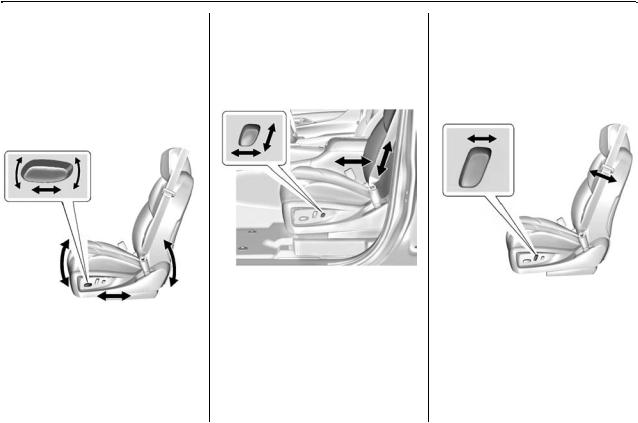
If equipped, the front and rear windows have an express-down feature. The front windows have an express-up feature. See Windows
0 49 and Power Windows 0 50.
Seat Adjustment
Power Seats
To adjust the seat:
.Move the seat forward or rearward by sliding the control forward or rearward.
.Raise or lower the front part of the seat cushion by moving the front of the control up or down.
.Raise or lower the seat by moving the rear of the control up or down.
See Power Seat Adjustment 0 56.
Lumbar Adjustment
To adjust the lumbar support:
.Press and hold the control forward to increase or rearward to decrease upper and lower lumbar support at the same time.
.Press and hold the control up to increase upper lumbar support and decrease lower lumbar support.
Press and hold the control down to increase lower lumbar support and decrease upper lumbar support.
See Lumbar Adjustment 0 58.
Reclining Seatbacks
To recline the seatback:
.Tilt the top of the control rearward to recline.
.Tilt the top of the control forward to raise.
See Reclining Seatbacks 0 58.
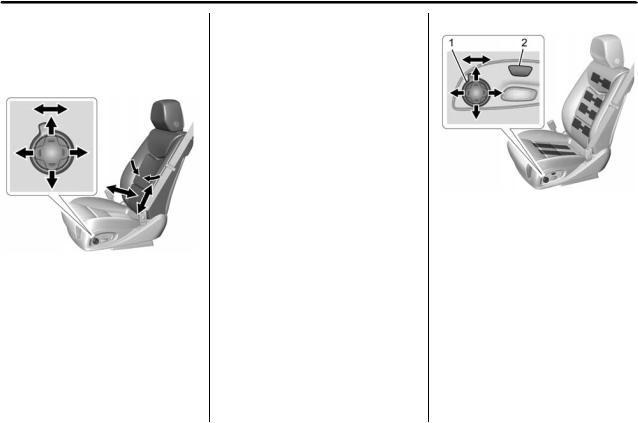
12 In Brief
Uplevel Seat Adjustment
If equipped, the ignition must be on to use all uplevel seat features.
Lumbar and Bolster Support
To adjust lumbar support, if equipped:
1.Turn the selection control to view seat options on the center stack display.
2.Select lumbar support.
3.Press forward or rearward to adjust the desired amount of support.
4.Press up or down to adjust the height of the support.
To adjust bolster support, if equipped:
1.Turn the selection control to view seat options on the center stack display.
2.Select bolster support.
3.Press forward or rearward to adjust the amount of bolster support.
See Power Seat Adjustment 0 56.
Massage
Driver Seat Shown, Passenger
Seat Similar
If equipped, the ignition must be on to use the massage feature.
Massage may also be activated and adjusted as follows:
1.Turn the selection control (1) to view massage options on the center stack display.
2.Select massage feature.
3.Press up or down to select massage type.
See Massage 0 60.
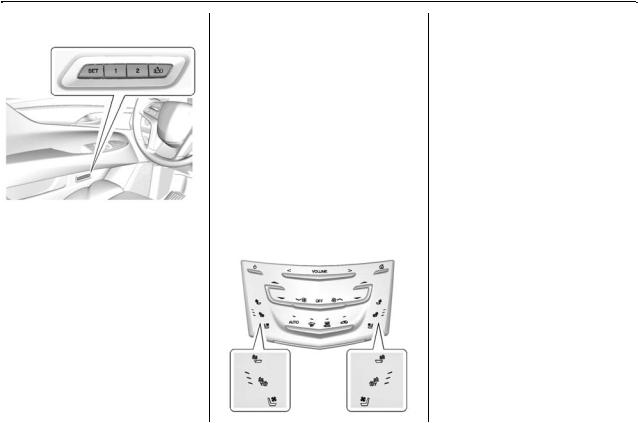
Memory Features
The SET, 1, 2, and B (Exit) buttons on the driver door are used to manually store and recall memory settings for the driver seat, outside mirrors, power tilt and telescoping steering column, adjustable pedals, and massage settings (if equipped).
Automatic Memory Recall and/or Easy Exit Recall features may be enabled in the vehicle personalization menus.
See Memory Seats 0 59 and
Vehicle Personalization 0 157.
Second Row Seats
The second row seatbacks can be folded for additional cargo space, or the seats can be folded and tumbled for easy entry/exit to the third row seats. The seatbacks also recline.
See Second Row Seats 0 63.
Third Row Seats
Third row seatbacks can be folded. See Third Row Seats 0 67.
Heated and Cooled Front
Seats
The buttons are near the climate controls on the center stack. To operate, the engine must be running.
Press I or +to heat the driver or passenger seatback only.
Press J or z to heat the driver or passenger seat cushion and seatback.
Press C or { to cool the driver or passenger seat.
See Heated and Cooled Front Seats 0 61.
Head Restraint
Adjustment
Do not drive until the head restraints for all occupants are installed and adjusted properly.
To achieve a comfortable seating position, change the seatback recline angle as little as necessary while keeping the seat and the head restraint height in the proper position.
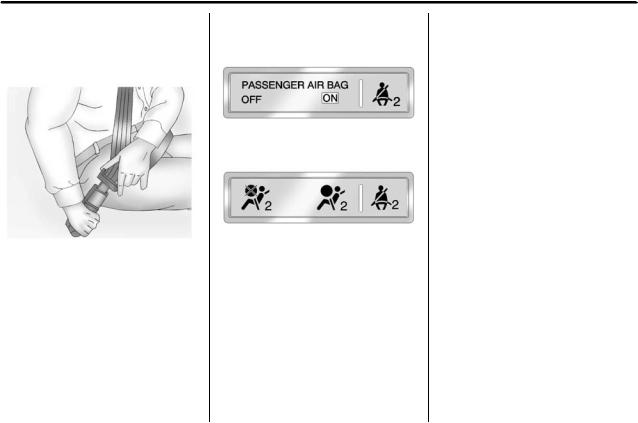
14 In Brief
See Head Restraints 0 55 and Power Seat Adjustment 0 56.
Safety Belts
Refer to the following sections for important information on how to use safety belts properly:
.Safety Belts 0 69.
.How to Wear Safety Belts Properly 0 70.
.Lap-Shoulder Belt 0 71.
.Lower Anchors and Tethers for Children (LATCH System) 0 97.
Passenger Sensing
System
United States
Canada and Mexico
The passenger sensing system will turn off the front outboard passenger frontal airbag under certain conditions. No other airbag is affected by the passenger sensing system. See Passenger Sensing System 0 84
The passenger airbag status indicator will light on the overhead console when the vehicle is started. See Passenger Airbag Status Indicator 0 130.
Mirror Adjustment
Interior Mirror
Adjustment
Adjust the rearview mirror for a clear view of the area behind the vehicle.
Automatic Dimming Rearview
Mirror
The mirror automatically dims to reduce the glare of headlamps from behind. The dimming feature comes on when the vehicle is started.
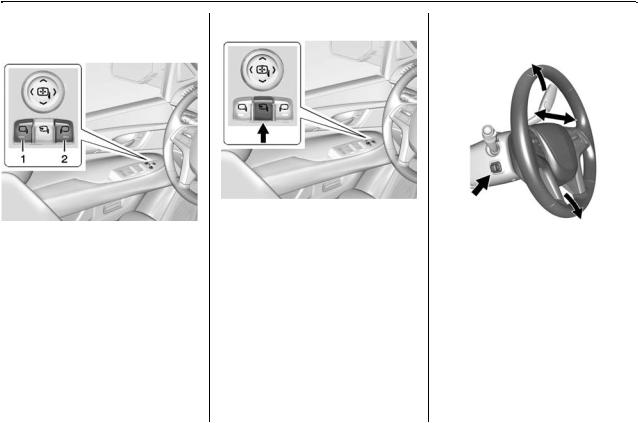
|
Exterior Mirrors |
Power Folding Mirrors |
Power Mirrors
Steering Wheel
Adjustment
To adjust the mirrors:
1.Press (1) or (2) to select the driver or passenger side mirror.
2.Press the arrows on the control pad to move each mirror in the desired direction.
3.Press either (1) or (2) again to deselect the mirror.
See Power Mirrors 0 47.
The vehicle has power folding mirrors. To adjust:
1.Press { to fold the mirrors inward.
2.Press { again to return the mirrors to the driving position.
Heated Mirrors
If equipped, press 1 to heat the outside mirrors.
See “Rear Window Defogger” under
Dual Automatic Climate Control System 0 178.
To adjust the power tilt and telescoping steering wheel, if equipped:
Press the control to move the steering wheel up and down or forward and rearward.
Do not adjust the steering wheel while driving.
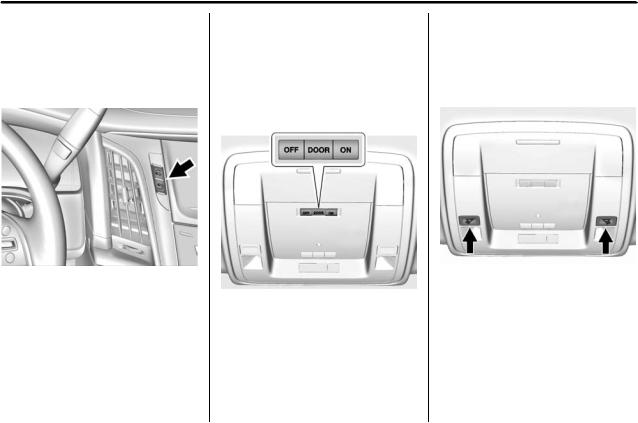
16 In Brief
Throttle and Brake Pedal
Adjustment
If equipped, the position of the throttle and brake pedals can be changed.
The switch used to adjust the pedals is on the center stack, to the left of the touch screen.
Press the top of the switch to move the pedals closer to your body. Press the bottom of the switch to move the pedals away.
See Adjustable Throttle and Brake
Pedal 0 203.
The vehicle may have a memory function, which lets pedal settings be saved and recalled. See Memory Seats 0 59.
Interior Lighting
Dome Lamps
There are dome lamps in the overhead console and the headliner, if equipped.
To change the dome lamp settings, press the following:
OFF : Turns the lamps off, even when a door is open.
DOOR : The lamps come on automatically when a door is opened.
ON : Turns all dome lamps on.
Reading Lamps
There are reading lamps in the overhead console and the headliner, if equipped. To operate, the ignition must be in the ACC/ACCESSORY or ON/RUN position or using Retained Accessory Power (RAP).

Press m or n next to each reading lamp to turn it on or off.
For more information about interior lighting, see Instrument Panel Illumination Control 0 173.
Exterior Lighting
The exterior lamp control is on the instrument panel to the left of the steering wheel.
P : Turns off the automatic headlamps and Daytime Running Lamps (DRL). Turning the headlamp control to the off position again will turn the automatic headlamps and DRL back on.
For vehicles first sold in Canada, the off position only works when the vehicle is shifted into the P (Park) position.
AUTO : Automatically turns the exterior lamps on and off, depending on outside lighting.
; : Turns on the parking lamps including all lamps, except the headlamps.
5 : Turns on the headlamps together with the parking lamps and instrument panel lights.
See:
.Exterior Lamp Controls 0 168
.Daytime Running Lamps (DRL) 0 170
.Automatic Headlamp System 0 171
Windshield Wiper/Washer
The windshield wiper control is on the turn signal lever.
The windshield wipers are controlled by turning the band with z FRONT on it.
1 : Fast wipes. w: Slow wipes.
3 INT : Use this setting for intermittent wipes or Rainsense™.
For intermittent wipes, turn the z

18 In Brief
FRONT band up for more frequent wipes or down for less frequent wipes.
To turn on Rainsense, press z AUTO on the lever, then turn the z FRONT band on the wiper lever to adjust the sensitivity.
.Turn the band up to a higher INT setting for more sensitivity to moisture.
.Turn the band down to the lower INT setting for less sensitivity to moisture.
Move the band out of the 3 INT position to deactivate Rainsense.
OFF : Turns the windshield wipers off.
8 : For a single wipe, turn to 8, then release. For several wipes,
hold the band on 8 longer.
Lm : Push the paddle at the top of the lever to spray washer fluid on the windshield.
See Windshield Wiper/Washer 0 117.
Climate Controls
The climate control buttons and the touch screen are used to adjust the heating, cooling, and ventilation.
Climate Control Buttons
1.Driver and Passenger Temperature Controls
2.Fan Control
3.OFF (Fan)
4.Driver and Passenger Heated and Cooled Seats (If Equipped)
5.Recirculation
6.Rear Window Defogger
7.Defrost
8. AUTO (Automatic Operation)
Climate Touch Screen Controls
1.Outside Temperature Display
2.Driver and Passenger Temperature Controls
3.Fan Control
4.SYNC (Synchronized Temperature)
5.A/C Mode (Air Conditioning)
6.Climate Control Selection (Application Tray Button)
7.Rear (Rear Climate Control Touch Screen)
8.Air Delivery Mode Control
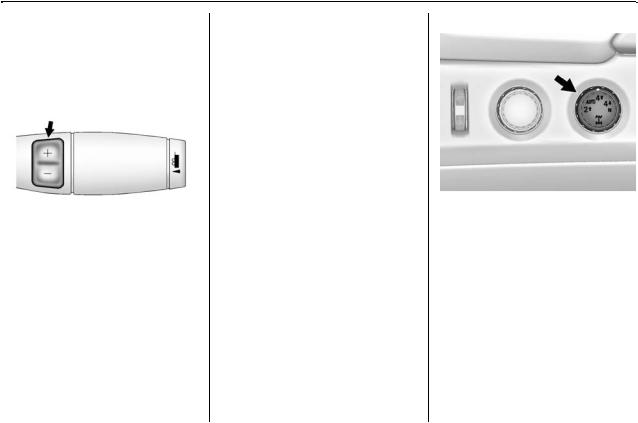
See Dual Automatic Climate Control System 0 178 and Rear Climate Control System 0 182 (If Equipped).
Transmission
Range Selection Mode
The Range Selection Mode switch, if equipped, is on the shift lever.
1.To enable the Range Selection feature, move the shift lever to the M (Manual Mode) position. The current range will appear next to the M. This is the highest attainable range with all lower gears accessible. As an example, when 5 (Fifth) gear is selected, 1 (First) through 5 (Fifth) gears are available.
2.Tap the plus/minus buttons on the shift lever to select the desired range of gears for current driving conditions. See
Manual Mode 0 213.
While using Range Selection Mode, cruise control and the Tow/Haul Mode can be used.
Grade Braking is not available when Range Selection Mode is active. See Tow/Haul Mode 0 216.
Four-Wheel Drive
If equipped, four-wheel drive engages the front axle for extra traction.
Automatic Transfer Case
Two Speed Automatic
Transfer Case
The transfer case knob is to the left of the steering wheel. Use this knob to shift into and out of the different four-wheel drive modes.
2 m : This setting is used for driving in most street and highway situations.
AUTO : This setting is ideal for use when road surface traction conditions are variable.
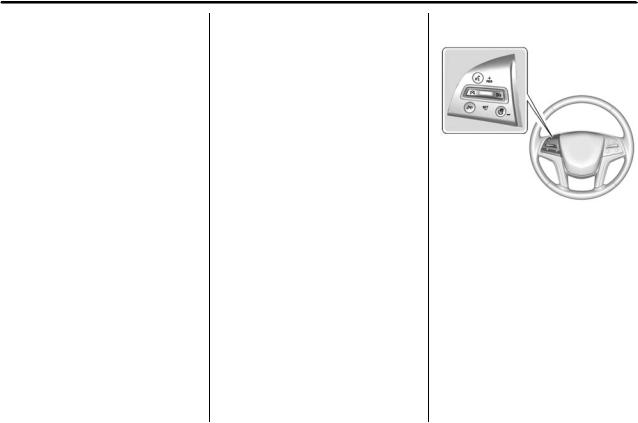
20 In Brief
4 m : Use the Four-Wheel Drive High position when extra traction is needed, such as on snowy or icy roads or in most off-road situations.
4 n : This setting engages the front axle and delivers extra torque. Choose 4 n if you are driving off-road in deep sand, mud,
or snow, and while climbing or descending steep hills.
N (Neutral) : Shift the transfer case to N (Neutral) only when towing the vehicle. See Recreational Vehicle Towing 0 333 or Towing the Vehicle 0 333.
See Four-Wheel Drive 0 217.
Vehicle Features
Infotainment System
See the infotainment manual for information on the radio, audio players, phone, navigation system, and voice or speech recognition. It also includes information on settings.
Steering Wheel Controls
The infotainment system can be operated by using the steering wheel controls. See «Steering Wheel Controls» in the infotainment manual.
Cruise Control
J : Press to turn the system on and off. A white indicator appears in the instrument cluster when cruise is turned on.
+RES : If there is a set speed in memory, press the control up briefly to resume that speed or press and hold to accelerate. If the cruise control is already active, use to increase vehicle speed.
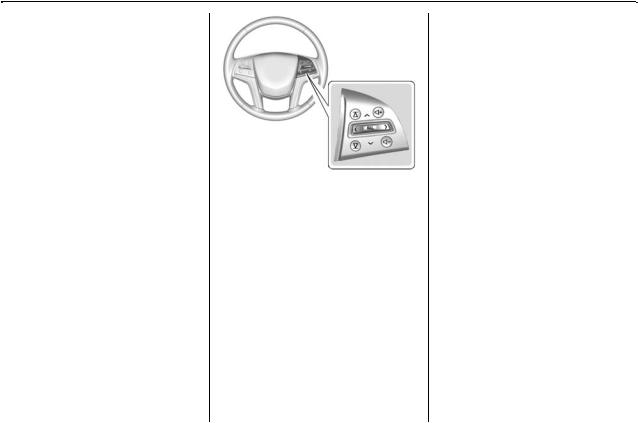
SET− : Press the control down briefly to set the speed and activate cruise control. If the cruise control is already active, use to decrease vehicle speed.
* : Press to disengage cruise control without erasing the set speed from memory.
See Cruise Control 0 227 or Adaptive Cruise Control 0 229 (if equipped).
Driver Information
Center (DIC)
The DIC display is in the instrument cluster. It shows the status of many vehicle systems.
y or z : Move SEL up or down to go to the previous or next selection.
S or T: Press to move between the interactive display zones in the
cluster. Press S to go back to the previous menu.
SEL : Press to open a menu or select a menu item. Press and hold to reset values on certain screens.
See Driver Information Center (DIC) 0 140.
Forward Collision Alert
(FCA) System
If equipped, FCA may help avoid or reduce the harm caused by front-end crashes. FCA provides a
green indicator, V, when a vehicle is detected ahead. This indicator displays amber if you follow a vehicle much too closely. When approaching a vehicle ahead too quickly, FCA provides a flashing red alert on the windshield and rapidly beeps or pulses the driver seat.
See Forward Collision Alert (FCA)
System 0 242.
Front Automatic Braking
(FAB) System
If the vehicle has Adaptive Cruise Control (ACC), it also has FAB, which includes Intelligent Brake Assist (IBA). When the system detects a vehicle ahead in your path that is traveling in the same direction that you may be about to crash into, it can provide a boost to braking or automatically brake the

22 In Brief
vehicle. This can help avoid or lessen the severity of crashes when driving in a forward gear.
See Front Automatic Braking (FAB)
System 0 244.
Lane Keep Assist (LKA)
If equipped, LKA may help avoid crashes due to unintentional lane departures. It may assist by gently turning the steering wheel if the vehicle approaches a detected lane marking without using a turn signal in that direction. It may also provide a Lane Departure Warning (LDW) alert as the lane marking is crossed. The system will not assist or alert if it detects that you are actively steering. Override LKA by turning the steering wheel. LKA uses a camera to detect lane markings between 60 km/h (37 mph) and
180 km/h (112 mph).
See Lane Departure Warning (LDW) 0 248 and Lane Keep Assist (LKA) 0 248.
Lane Change Alert (LCA)
If equipped, the LCA system is a lane-changing aid that assists drivers with avoiding lane change crashes that occur with moving vehicles in the side blind zone (or spot) areas or with vehicles rapidly approaching these areas from behind. The LCA warning display will light up in the corresponding outside side mirror and will flash if the turn signal is on. The Side Blind Zone Alert (SBZA) system is included as part of the LCA system.
See Side Blind Zone Alert (SBZA) 0 245 and Lane Change Alert (LCA) 0 246.
Surround Vision
If equipped, views around the vehicle display on the center stack to aid with parking and low-speed maneuvers.
See “Surround Vision” under
Assistance Systems for Parking or Backing 0 237.
Front Vision Camera
If equipped, a view of the area in front of the vehicle displays on the center stack to aid with parking and low-speed maneuvers.
See “Front Vision Camera” under
Assistance Systems for Parking or Backing 0 237.
Rear Vision
Camera (RVC)
If equipped, RVC displays a view of the area behind the vehicle on the center stack display when the vehicle is shifted into R (Reverse) to aid with parking and low-speed backing maneuvers.
See Assistance Systems for Parking or Backing 0 237.
Rear Cross Traffic Alert
(RCTA) System
If equipped, the RCTA system uses a triangle with an arrow displayed on the RVC screen to warn of traffic behind your vehicle that may cross

your vehicle’s path while in
R (Reverse). In addition, beeps will sound, or the driver seat will pulse.
See Assistance Systems for Parking or Backing 0 237.
Parking Assist
If equipped, Front and Rear Parking Assist (FRPA) uses sensors on the front and rear bumpers to assist with parking and avoiding objects during low speed parking maneuvers. It operates at speeds less than 8 km/h (5 mph). FRPA may display a warning triangle on the Rear Vision Camera screen and a graphic on the instrument cluster to provide the object distance. In addition, multiple beeps or seat pulses may occur if very close to an object.
The vehicle may also have a higher speed Backing Warning System and the Rear Automatic Braking system.
See Driver Assistance Systems 0 236.
Rear Automatic Braking
(RAB) System
If the vehicle has Adaptive Cruise Control (ACC) it also has the RAB system, which is designed to help avoid or reduce the harm caused by backing crashes when the vehicle is shifted into R (Reverse). If the system detects the vehicle is backing too fast to avoid a crash with a detected object behind your vehicle in your path, it may automatically brake hard to a stop.
See Assistance Systems for Parking or Backing 0 237.
Power Outlets
Power Outlets 12 Volt Direct
Current
Accessory power outlets can be used to plug in electrical equipment, such as a cell phone, MP3
player, etc.
The vehicle has five accessory power outlets:
.One near the cupholders on the center console.
.One inside the center console.
.One on the rear of the center console.
.One in the third row seat on the driver side.
.One in the rear cargo area on the passenger side.
Lift the cover to access and replace when not in use.
See Power Outlets 0 121.
Universal Remote System
If equipped with the Universal Remote system, these buttons will be in the front overhead console.
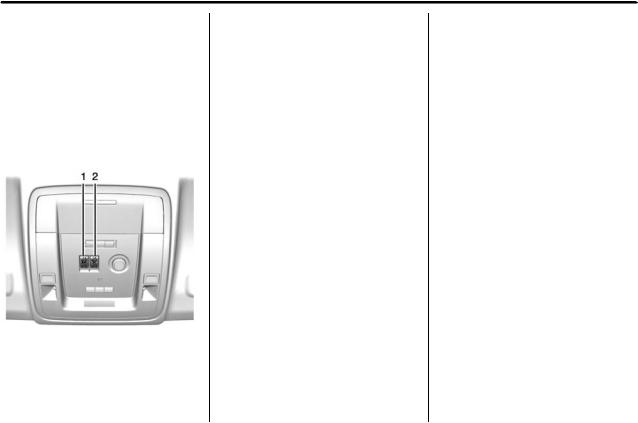
24 In Brief
This system provides a way to replace up to three remote control transmitters used to activate devices such as garage door openers, security systems, and home automation devices.
See Universal Remote System 0 164.
Sunroof
1.Open or Close
2.Vent
On vehicles with a sunroof, the sunroof only operates when the ignition is in ACC/ACCESSORY or ON/RUN, or when Retained Accessory Power (RAP) is active. See Retained Accessory Power (RAP) 0 207.
Vent : From the closed position, press the rear of switch (2) to vent the sunroof.
Open/Close : To open the sunroof, press and hold switch (1) until the sunroof reaches the desired position. Press and hold the front of switch (1) to close it.
Express-Open/Express-Close : To express-open the sunroof, fully press and release the rear of switch (1) until the sunroof reaches the desired position. To express-close the sunroof, fully press and release the front of switch (1). Press the switch again to stop it.
When the sunroof is opened, an air deflector will automatically raise. The air deflector will retract when the sunroof is closed.
The sunroof also has a sunshade which can be pulled forward to block sun rays. The sunshade must be opened and closed manually.
If an object is in the path of the sunroof while it is closing, the anti-pinch feature will detect the object and stop the sunroof.
See Sunroof 0 52.

Performance and
Maintenance
Traction Control/
Electronic Stability
Control
The vehicle has a traction control system that limits wheel spin and the StabiliTrak system that assists with directional control of the vehicle in difficult driving conditions. Both systems come on automatically when the vehicle is started and begins to move.
.To turn off traction control, press and release g on the center stack. The traction off light i displays in the instrument cluster. The appropriate Driver Information Center (DIC) message displays. See Ride Control System Messages
0 153.
.To turn off both traction control and StabiliTrak, press and
hold g until i and g illuminate
in the instrument cluster and the appropriate DIC message displays. See Ride Control System Messages 0 153.
.Press and release g again to turn on both systems.
StabiliTrak will automatically turn on if the vehicle exceeds 56 km/h
(35 mph). Traction control will remain off.
See Traction Control/Electronic
Stability Control 0 224.
Tire Pressure Monitor
This vehicle may have a Tire Pressure Monitor System (TPMS).
The low tire pressure warning light alerts to a significant loss in pressure of one of the vehicle’s tires. If the warning light comes on, stop as soon as possible and inflate
the tires to the recommended pressure shown on the Tire and Loading Information label. See
Vehicle Load Limits 0 198. The warning light will remain on until the tire pressure is corrected.
The low tire pressure warning light may come on in cool weather when the vehicle is first started, and then turn off as the vehicle is driven. This may be an early indicator that the tire pressures are getting low and the tires need to be inflated to the proper pressure.
The TPMS does not replace normal monthly tire maintenance. Maintain the correct tire pressures.
See Tire Pressure Monitor System 0 308.
Engine Oil Life System
The engine oil life system calculates engine oil life based on vehicle use and displays the CHANGE ENGINE OIL SOON message when it is time to change the engine oil and filter.
The oil life system should be reset to 100% only following an oil change.

26 In Brief
Resetting the Oil Life System
1.Using the DIC controls on the right side of the steering wheel, display OIL LIFE on the DIC. See Driver Information Center (DIC) 0 140. When remaining oil life is low, the CHANGE ENGINE OIL SOON message will appear on the display. See
Engine Oil Messages 0 149.
2.Press SEL on the DIC controls and hold SEL down for a few seconds to clear the CHANGE ENGINE OIL SOON message and reset the oil life at 100%.
Be careful not to reset the oil life display accidentally at any time other than after the oil is changed. It cannot be reset accurately until the next oil change.
The oil life system can also be reset as follows:
1.Turn the ignition on with the engine off.
2.Fully press and release the accelerator pedal three times within five seconds.
If the CHANGE ENGINE OIL SOON message is not on, the system is reset.
See Engine Oil Life System 0 271.
Driving for Better Fuel Economy
Driving habits can affect fuel mileage. Here are some driving tips to get the best fuel economy possible.
.Avoid fast starts and accelerate smoothly.
.Brake gradually and avoid abrupt stops.
.Avoid idling the engine for long periods of time.
.When road and weather conditions are appropriate, use cruise control.
.Always follow posted speed limits or drive more slowly when conditions require.
.Keep vehicle tires properly inflated.
.Combine several trips into a single trip.
.Replace the vehicle’s tires with the same TPC Spec number molded into the tire’s sidewall near the size.
.Follow recommended scheduled maintenance.
Roadside Service
U.S.: 1-800-224-1400
Canada: 1-800-882-1112
TTY Users (U.S. Only): 1-888-889-2438
New Cadillac owners are automatically enrolled in the Roadside Service Program.
See Roadside Service 0 366.

Keys, Doors, and Windows 27
Keys, Doors, and
Windows
Keys and Locks
Keys . . . . . . . . . . . . . . . . . . . . . . . . . . . 27
Remote Keyless Entry (RKE)
System . . . . . . . . . . . . . . . . . . . . . . . 28
Remote Keyless Entry (RKE)
System Operation . . . . . . . . . . . . 28
Remote Vehicle Start . . . . . . . . . . 35
Door Locks . . . . . . . . . . . . . . . . . . . . 36
Power Door Locks . . . . . . . . . . . . . 37
Delayed Locking . . . . . . . . . . . . . . . 37
Automatic Door Locks . . . . . . . . . 38
Lockout Protection . . . . . . . . . . . . . 38
Safety Locks . . . . . . . . . . . . . . . . . . . 38
Doors
Liftgate . . . . . . . . . . . . . . . . . . . . . . . . 39
Power Assist Steps . . . . . . . . . . . . 43
Vehicle Security
Vehicle Security . . . . . . . . . . . . . . . . 44
Vehicle Alarm System . . . . . . . . . 44
Immobilizer . . . . . . . . . . . . . . . . . . . . 46
Immobilizer Operation . . . . . . . . . 46
Exterior Mirrors
Power Mirrors . . . . . . . . . . . . . . . . . . 47
Folding Mirrors . . . . . . . . . . . . . . . . . 48
Heated Mirrors . . . . . . . . . . . . . . . . . 48
Reverse Tilt Mirrors . . . . . . . . . . . . 48
Interior Mirrors
Interior Rearview Mirrors . . . . . . . 49
Automatic Dimming Rearview
Mirror . . . . . . . . . . . . . . . . . . . . . . . . . 49
Child-View Mirror . . . . . . . . . . . . . . 49
Windows
Windows . . . . . . . . . . . . . . . . . . . . . . . 49
Power Windows . . . . . . . . . . . . . . . 50
Sun Visors . . . . . . . . . . . . . . . . . . . . . 52
Roof
Sunroof . . . . . . . . . . . . . . . . . . . . . . . . 52
Keys and Locks
Keys
{Warning
Leaving children in a vehicle with a Remote Keyless Entry (RKE) transmitter is dangerous and children or others could be seriously injured or killed. They could operate the power windows or other controls or make the vehicle move. The windows will function with the RKE transmitter in the vehicle, and children or others could be caught in the path of a closing window. Do not leave children in a vehicle with an RKE transmitter.
Convex Mirrors . . . . . . . . . . . . . . . . 47
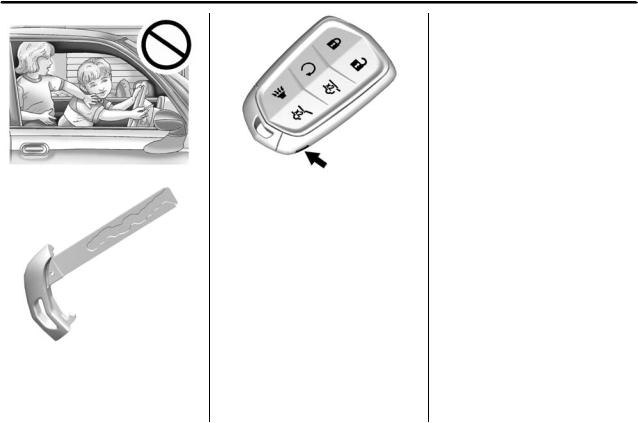
28 Keys, Doors, and Windows
|
The transmitter has a button on the |
|
|
side used to remove the key. Do not |
|
|
pull the key out without pressing the |
|
|
button. |
|
|
See your dealer if a replacement |
|
|
key or additional key is needed. |
|
|
With an active OnStar subscription, |
|
|
an OnStar Advisor may remotely |
|
|
unlock the vehicle. See OnStar |
|
|
Overview 0 376. |
|
|
The key is used for the driver door. |
Remote Keyless Entry |
|
(RKE) System |
|
|
See Radio Frequency Statement |
|
|
0 373. |
If there is a decrease in the RKE operating range:
.Check the distance. The transmitter may be too far from the vehicle.
.Check the location. Other vehicles or objects may be blocking the signal.
.Check the transmitter’s battery. See “Battery Replacement” later in this section.
.If the transmitter is still not working correctly, see your dealer or a qualified technician for service.
Remote Keyless Entry
(RKE) System Operation
The Keyless Access system allows for vehicle entry when the transmitter is within 1 m (3 ft). See “Keyless Access Operation” later in this section.
The RKE transmitter functions may work up to 60 m (197 ft) away from the vehicle.
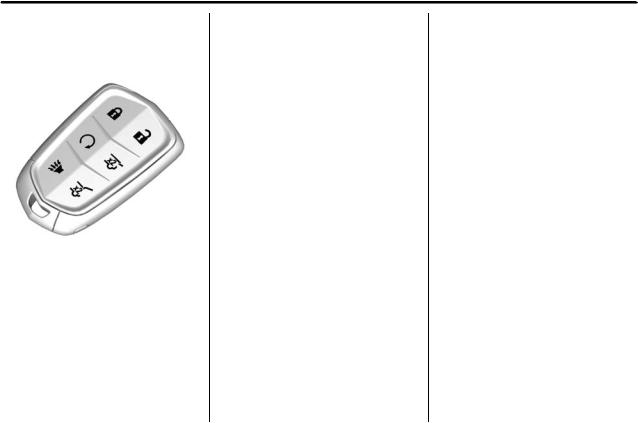
Keys, Doors, and Windows 29
Other conditions can affect the performance of the transmitter. See
Remote Keyless Entry (RKE) System 0 28.
/ (Remote Vehicle Start) :
If equipped, press and release Q,
then immediately press and hold / until the turn signals flash or for at least four seconds. The engine may be started from outside the vehicle using the RKE transmitter. See
Remote Vehicle Start 0 35.
Q (Lock) : Press to lock all doors.
If enabled through the Driver Information Center (DIC), the turn signal lamps flash once to indicate locking has occurred. If enabled through the DIC, the horn chirps
when Q is pressed again within three seconds. See Vehicle Personalization 0 157.
If the driver door is open when Q is pressed, all door will lock and then the driver door will immediately unlock, if enabled in Vehicle Personalization. See Vehicle Personalization 0 157. If the
passenger door is open when Q is pressed, all doors lock.
If the passenger door is open when Q is pressed, all doors lock.
Pressing Q arms the alarm system. See Vehicle Alarm System 0 44.
If equipped with auto mirror folding, pressing and holding Q for
one second will fold the mirrors. The auto mirror folding feature will not operate unless it is enabled. See
Vehicle Personalization 0 157.
K (Unlock) : Press once to unlock only the driver door. If K is pressed again within three seconds, all remaining doors unlock. The interior lamps may come on and stay on for 20 seconds or until the ignition is turned on.
If enabled through the DIC, the turn signal lamps flash twice to indicate unlocking has occurred. If enabled through the DIC, the exterior lamps may turn on. See Vehicle Personalization 0 157.
Pressing K on the RKE transmitter disarms the alarm system. See
Vehicle Alarm System 0 44.
If equipped with auto mirror folding, pressing and holding K for
one second will unfold the mirrors. The auto mirror folding feature will not operate unless it is enabled.
See Vehicle Personalization 0 157.

30 Keys, Doors, and Windows
Press and hold K until the windows fully open. Windows will not operate unless remote window operation is enabled. See Vehicle Personalization 0 157
c(Liftglass) : Press twice to open the liftglass.
b(Liftgate) : Press twice to open or close the liftgate. Press once to stop the liftgate from moving.
7 (Vehicle Locator/Panic Alarm) : Press and release to initiate vehicle locate. The turn signal lamps flash and the horn sounds three times.
Press and hold 7 for more than three seconds to activate the panic alarm. The turn signal lamps flash and the horn sounds repeatedly for 30 seconds. The alarm turns off when the ignition is moved to ON/
RUN or 7 is pressed again. The ignition must be in LOCK/OFF for the panic alarm to work.
Keyless Access Operation
The Keyless Access system allows for the doors and liftgate to be accessed without pressing the RKE transmitter button. The RKE transmitter must be within 1 m (3 ft) of the door being opened. If the vehicle has this feature, there will be a button on the outside door handles.
Keyless Access can be programmed to unlock all doors on the first lock/unlock press from the driver door. See Vehicle Personalization 0 157.
Keyless Unlocking/Locking from the Driver Door
When the doors are locked and the RKE transmitter is within 1 m (3 ft) of the door handle, pressing the lock/unlock button on the driver door handle will unlock the driver door.
If the lock/unlock button is pressed again within five seconds, all passenger doors and the liftgate will unlock.
Driver Side Shown, Passenger
Similar
Pressing the lock/unlock button will cause all doors to lock if any of the following occur:
.It has been more than
five seconds since the first lock/ unlock button press.
.Two lock/unlock button presses were used to unlock all doors.
.Any vehicle door has been opened and all doors are now closed.

Keys, Doors, and Windows 31
Keyless Unlocking/Locking from the Passenger Doors
When the doors are locked and the RKE transmitter is within 1 m (3 ft) of the door handle, pressing the lock/unlock button on a passenger door handle will unlock all doors. Pressing the lock/unlock button will cause all doors to lock if any of the following occur:
.The lock/unlock button was used to unlock all doors.
.Any vehicle door has been opened and all doors are now closed.
Passive Locking
Keyless Access will lock the vehicle several seconds after all doors are closed, if the vehicle is off and at least one RKE transmitter has been removed from the interior, or none remain in the interior.
If other electronic devices interfere with the RKE transmitter signal, the vehicle may not detect the RKE transmitter inside the vehicle.
If passive locking is enabled, the doors may lock with the RKE
transmitter inside the vehicle. Do not leave the RKE transmitter in an unattended vehicle.
To customize the doors to automatically lock when exiting the vehicle, see “Remote Lock, Unlock, Start” under Vehicle Personalization 0 157.
Temporarily Disable of Passive
Locking Feature
Temporarily disable passive locking by pressing and holding K on the interior door switch with a door open for at least four seconds, or until three chimes are heard. Passive locking will then remain disabled until Q on the interior door is pressed, or until the vehicle is turned on.
Keyless Liftgate Opening
Press the touch pad on the rear of the liftgate above the license plate to open the liftgate when all doors are unlocked or when the transmitter is within 1 m (3 ft).
Keyless Liftglass Opening
Press the exterior liftglass button to open the liftglass when all doors are unlocked or when the transmitter is within 1 m (3 ft).
Key Access
To access a vehicle with a dead transmitter battery, see Door Locks
0 36.
Programming Transmitters to the Vehicle
Only RKE transmitters programmed to the vehicle will work. If a transmitter is lost or stolen, a replacement can be purchased and programmed through your dealer. The vehicle can be reprogrammed so that lost or stolen transmitters no longer work. Each vehicle can have up to eight transmitters matched
to it.
Programming with a Recognized Transmitter
A new transmitter can be programmed to the vehicle when there is one recognized transmitter.

32 Keys, Doors, and Windows
To program, the vehicle must be off and all transmitters, both currently recognized and new, must be
with you.
1.Remove the key from the recognized transmitter.
2.Place the recognized transmitter(s) in the cupholder or on the passenger seat.
3.Remove the key lock cylinder cap on the driver door handle. See Door Locks 0 36. Insert the vehicle key into the key lock cylinder on the driver door handle; then turn the key counterclockwise, to the unlock position five times within
10 seconds.
The Driver Information Center (DIC) displays READY FOR REMOTE #2, 3, 4, ETC.
4.Open the center console storage area and the storage tray.
5.Place the new transmitter in the transmitter pocket/insert, in front of the center console storage area.
6.Press the ENGINE START/ STOP button. When the transmitter is learned, the DIC display will show that it is ready to program the next transmitter.
7.Remove the transmitter from the transmitter pocket/insert and press K or Q on the transmitter.
To program additional transmitters, repeat Steps 4–7.
When all additional transmitters are programmed, press and hold the ENGINE START/ STOP button for approximately 12 seconds to exit programming mode.
8.Put the key back into the transmitter.
Programming without a
Recognized Transmitter
If there are no currently recognized transmitters available, follow this procedure to program up to eight transmitters. This feature is not available in Canada. This procedure will take approximately 30 minutes to complete. The vehicle must be off and all transmitters to be programmed must be with you.
1.Remove the vehicle key from the transmitter.
2.Remove the key lock cylinder cap on the driver door handle. See Door Locks 0 36. Insert the vehicle key into the key lock cylinder on the driver door

Keys, Doors, and Windows 33
handle; then turn the key counterclockwise, to the unlock position, five times within
10 seconds.
The Driver Information Center (DIC) displays REMOTE LEARN PENDING,
PLEASE WAIT.
3.Wait for 10 minutes until the DIC displays PRESS ENGINE START BUTTON TO LEARN, then press the ENGINE START/STOP button.
The DIC display will again show REMOTE LEARN PENDING, PLEASE WAIT.
4.Repeat Step 3 two additional times. After the third time all previously known transmitters will no longer work with the vehicle. Remaining transmitters can be relearned during the next steps.
The DIC display should now show READY FOR REMOTE
# 1.
5.Place the new transmitter in the transmitter pocket/insert, In front of the center console storage area. The storage area will need to be opened to access the transmitter pocket/ insert.
6.Press the ENGINE START/ STOP button. When the transmitter is learned, the DIC display will show that it is ready to program the next transmitter.
7.Remove the transmitter from the transmitter pocket/insert and press K or Q on the transmitter.
To program additional transmitters, repeat Steps 5–7.
When all additional transmitters are programmed, press and hold the ENGINE START/ STOP button for approximately 12 seconds to exit programming mode.
8.Return the key back into the transmitter.
Starting the Vehicle with a Low Transmitter Battery
If the transmitter battery is weak or if there is interference with the signal, the DIC may display NO REMOTE DETECTED or NO REMOTE KEY WAS DETECTED PLACE KEY IN TRANSMITTER POCKET THEN START YOUR VEHICLE when starting the vehicle. See Key and Lock Messages 0 149.
To start the vehicle:
1.Open the center console storage area and the storage tray.

34 Keys, Doors, and Windows
2.Place the transmitter in the transmitter pocket/insert.
3.With the vehicle in P (Park) or N (Neutral) press the brake pedal and the ENGINE START/ STOP button.
Replace the transmitter battery as soon as possible.
Battery Replacement
Caution
When replacing the battery, do not touch any of the circuitry on the transmitter. Static from your body could damage the transmitter.
Replace the battery if the REPLACE BATTERY IN REMOTE KEY message displays in the DIC.
1.Press the button on the side of the transmitter near the bottom and pull the key out.
2.Separate the two halves of the transmitter using a flat tool inserted into the bottom center of the transmitter. Do not use the key slot.

Keys, Doors, and Windows 35
3.Remove the old battery. Do not use a metal object.
4.Insert the new battery on the back housing, positive side facing down. Replace with a CR2032 or equivalent battery.
5.Align the front and back housing then snap the transmitter together.
Remote Vehicle Start
If equipped with the remote start feature, the climate control system will come on when the vehicle is started remotely depending on the outside temperature.
The rear defog and heated and cooled seats, if equipped, may also come on. See Heated and Cooled Front Seats 0 61 and Vehicle Personalization 0 157.
Laws in some communities may restrict the use of remote starters. Check local regulations for any requirements on remote starting of vehicles.
Do not use remote start if the vehicle is low on fuel.
The vehicle cannot be remote started if:
.The transmitter is in the vehicle.
.The hood is not closed.
.There is an emission control system malfunction and the malfunction indicator lamp is on.
The engine will turn off during a remote vehicle start if:
.The coolant temperature gets too high.
.The oil pressure gets low.
The RKE transmitter range may be less while the vehicle is running.
Other conditions can affect the performance of the transmitter. See
Remote Keyless Entry (RKE) System 0 28 or Vehicle Personalization 0 157.
Starting the Engine Using Remote
Start
1.Press and release Q.
2.Immediately press and hold / until the turn signal lamps flash or for at least four seconds.
When the vehicle starts, the parking lamps will turn on. The doors will be locked and the climate control system may come on.
The engine will continue to run for 10 minutes. Repeat the Steps 1 and 2 for one 10-minute time extension.
Place the ignition in ON/RUN/ START to operate the vehicle.
Extending Engine Run Time
The engine run time can be extended by 10 minutes, for a total of 20 minutes, if during the first

36 Keys, Doors, and Windows
10 minutes Steps 1 and 2 are repeated while the engine is still running. An extension can be requested 30 seconds after starting.
A maximum of two remote starts, or a single start with an extension, is allowed between ignition cycles.
The vehicle’s ignition must be turned on and then back off to use remote start again.
Canceling a Remote Start
To cancel a remote start, do one of the following:
.Press and hold / until the parking lamps turn off.
.Turn on the hazard warning flashers.
.Turn the ignition on and then off.
Door Locks
{Warning
Unlocked doors can be dangerous.
(Continued)
Warning (Continued)
.Passengers, especially children, can easily open the doors and fall out of a moving vehicle. When a door is locked, the handle will not open it. The chance of being thrown out of the vehicle in a crash is increased if the doors are not locked. So, all passengers should wear safety belts properly and the doors should be locked whenever the vehicle is driven.
.Young children who get into unlocked vehicles may be unable to get out. A child can be overcome by extreme heat and can suffer permanent injuries or even death from heat stroke. Always lock the vehicle whenever leaving it.
(Continued)
Warning (Continued)
.Outsiders can easily enter through an unlocked door when you slow down or stop the vehicle. Locking the doors can help prevent this from happening.
To lock the doors from inside the vehicle:
.Press Q on a power door lock switch.
.Push down the manual lock knob on the driver door to lock all doors. Push down the manual lock knob on a passenger door to lock only that door.
To unlock the doors from inside the vehicle:
.Press K on a power door lock switch.
.Pull the door handle once to unlock it. Pull the door handle again to unlatch it.

Keys, Doors, and Windows 37
From outside the vehicle use the Remote Keyless Entry (RKE) transmitter or the key in the front doors. The key cylinder is covered by a cap.
Key Cylinder Access
To access the key cylinder:
1.Pull the handle open fully.
2.Slide the cap inward and remove to expose the key cylinder.
3.Replace cap by sliding it back on.
Keyless Access
A locked vehicle can be opened if the RKE transmitter is within 1 m (3 ft) of the door handle or the liftgate touch pad. See Remote Keyless Entry (RKE) System Operation 0 28.
Free Turning Locks
The door lock cylinder turns freely when either the wrong key is used, or the correct key is not fully inserted. The free turning door lock feature prevents the lock from being forced open. To reset the lock, turn it to the vertical position with the correct key fully inserted. Remove the key and insert it again. If this does not reset the lock, turn the key halfway around in the cylinder and repeat the reset procedure.
Power Door Locks
Press Q or K on the Remote Keyless Entry (RKE) transmitter. See Remote Keyless Entry (RKE) System Operation 0 28.
Q (Lock) : Press to lock the doors.
K (Unlock) : Press to unlock the doors.
Delayed Locking
This feature delays the locking of the doors until five seconds after all doors are closed.
When Q is pressed on the power door lock switch while a door or the liftgate is open, a chime will sound three times indicating delayed locking is active.

38 Keys, Doors, and Windows
The doors will lock automatically five seconds after all doors are closed. If a door is reopened before that time, the five-second timer will reset when all doors are closed again.
Press Q on the door lock switch
again or press Q on the RKE transmitter to lock doors immediately.
This feature can also be programmed. See Vehicle Personalization 0 157.
Automatic Door Locks
The vehicle may have an automatic lock/unlock feature. This feature can be programmed using the Driver Information Center (DIC). See
Vehicle Personalization 0 157.
Lockout Protection
If the vehicle is in ACC/ ACCESSORY or ON/RUN and the power door lock switch is pressed with the driver door open, all the doors will lock and only the driver door will unlock.
If the vehicle is off and locking is requested while a door is open, when all doors are closed the vehicle will check for RKE transmitters inside. If an RKE transmitter is detected and the number of RKE transmitters inside has not reduced, the driver door will unlock and the horn will chirp three times.
Lockout Protection can be manually overridden with the driver door open
by pressing and holding Q on the power door lock switch.
Unlocked Door Anti-Lockout
If Unlocked Door Anti-Lockout is turned on and the vehicle is off, the driver door is open, and locking is requested, all the doors will lock and only the driver door will unlock. The Unlocked Door Anti-Lockout feature can be turned on or off using the vehicle personalization menus. See
Vehicle Personalization 0 157.
Safety Locks
The rear door safety locks prevent passengers from opening the rear doors from inside the vehicle.
Press { to activate the safety locks on the rear doors. The indicator light comes on when activated.
Press { again to deactivate the safety locks.

Keys, Doors, and Windows 39
Doors
Liftgate
{Warning
Exhaust gases can enter the vehicle if it is driven with the liftgate or trunk/hatch open, or with any objects that pass through the seal between the body and the trunk/hatch or
liftgate. Engine exhaust contains carbon monoxide (CO) which cannot be seen or smelled. It can cause unconsciousness and even death.
If the vehicle must be driven with the liftgate or trunk/hatch open:
.Close all of the windows.
.Fully open the air outlets on or under the instrument panel.
.Adjust the climate control system to a setting that brings in only outside air
(Continued)
Warning (Continued)
and set the fan speed to the highest setting. See “Climate Control Systems” in the Index.
.If the vehicle is equipped with a power liftgate, disable the power liftgate function.
See Engine Exhaust 0 210.
Caution
To avoid damage to the liftgate or liftgate glass, make sure the area above and behind the liftgate is clear before opening it.
Manual Liftgate
To open the liftgate, press K on the
power door lock switch or press K on the RKE transmitter twice to unlock all doors. Press the touch pad (1) on the underside of the liftgate handle and lift up.
Press the button (2) above the license plate to open the liftglass,
or press c twice quickly on the RKE transmitter. Do not leave the liftglass open when raising the liftgate.

40 Keys, Doors, and Windows
There will be a delay in the release of the liftglass if there is an attempt to open it while the rear wipers are in motion.
Use the pull cup to lower and close the liftgate. Do not press the touch pad while closing the liftgate. This will cause the liftgate to be unlatched.
If equipped with Keyless Access, the RKE transmitter must be within 1 m (3 ft) of the liftgate to automatically unlock it. See Remote Keyless Entry (RKE) System Operation 0 28.
The liftgate has an electric latch.
If the battery is disconnected or has low voltage, the liftgate will not open. The liftgate will resume operation when the battery is reconnected and charged.
Power Liftgate Operation
{Warning
You, or others, could be injured if caught in the path of the power liftgate. Make sure there is no one in the way of the liftgate as it is opening and closing.
If equipped, the switch is on the overhead console. The vehicle must be in P (Park).
The modes are:
.MAX: Opens to maximum height.
.3/4: Opens to a reduced height that can be set from 3/4 to fully open. Use to prevent the liftgate from opening into overhead objects such as a garage door or roof-mounted cargo. The liftgate can be opened all the way manuallly.
.OFF: Opens manually only.
To open or close the liftgate, select MAX or 3/4 mode and then:
.Press b twice quickly on the RKE transmitter until the liftgate moves.
.Press 8on the overhead console. The driver door must be unlocked.
.Press the touch pad on the outside liftgate handle after unlocking all doors. If equipped with Keyless Access, a locked vehicle can be opened if the RKE transmitter is within 1 m (3 ft) of the touch pad.

Keys, Doors, and Windows 41
.Press lon the bottom edge of the liftgate next to the latch to close.
Press any liftgate button, the touch pad, or b on the RKE transmitter while the liftgate is moving to stop it. Pressing again restarts the operation in the reverse direction. The touch pad on the liftgate handle cannot be used to close the liftgate.
Do not manually force the liftgate to open or close during a power cycle.
The power liftgate may be temporarily disabled in extremely low temperatures, or after repeated power cycling over a short period of
time. If this occurs, the liftgate can still be operated manually. Select OFF on the liftgate switch.
If the vehicle is shifted out of
P (Park) while the power function is in progress, the liftgate will continue to completion. If the vehicle is accelerated before the liftgate has completed moving, the liftgate may stop or reverse direction. Make sure the liftgate is closed and latched before driving.
If the power liftgate support strut has lost pressure, the turn signals will flash and a chime will sound while the liftgate automatically closes. See your dealer for service before using the power liftgate.
Obstacle Detection Features
If the liftgate encounters an obstacle during a power open or close cycle, a warning chime will sound and the liftgate will automatically reverse direction and move a short distance away from the obstacle. After removing the obstruction, the power liftgate operation can be used again. If the liftgate encounters multiple obstacles on the same power cycle,
the power function will deactivate. After removing the obstructions, manually close the liftgate. This will allow normal power operation functions to resume.
If the vehicle is locked while the liftgate is closing, and an obstacle prevents the liftgate from completely closing, the horn will sound as an alert that the liftgate did not close.
Pinch sensors are on the side edges of the liftgate. If an object is caught between the liftgate and the vehicle and presses against a sensor, the liftgate will reverse direction and open fully. The liftgate will remain open until it is activated again or closed manually.
Setting the 3/4 Mode
To change the position the liftgate stops at when opening:
1.Select MAX or 3/4 mode and open the liftgate.
2.Stop the liftgate movement at the desired height by pressing any liftgate button. Manually adjust the liftgate position if needed.

42 Keys, Doors, and Windows
3.Press and hold lnext to the latch on the outside of the liftgate until the turn signals flash and a beep sounds. This indicates the setting has been recorded.
The liftgate cannot be set below a minimum programmable height. If there is no light flash or sound,
then the height adjustment may be too low.
Manual Operation
Select OFF to manually operate the liftgate. See “Manual Liftgate” at the beginning of this section.
Caution
Do not use too much force when closing the liftgate to avoid damage.
Hands-Free Operation
If equipped with Hands-Free Vehicle Access, the liftgate may be operated with a kicking motion under the rear bumper.
The liftgate will not operate if the RKE transmitter is not within
1 m (3 ft).
The hands-free feature will not work while the liftgate is moving. To stop the liftgate while in motion use one of the liftgate switches.
Length of Kick Zone
To operate, kick your foot straight up in one swift motion under the center of the rear bumper, then pull it back.

Keys, Doors, and Windows 43
Caution
Splashing water may cause the liftgate to open. Keep the RKE transmitter away from the rear bumper detection area or turn the liftgate mode to OFF when cleaning or working near the rear bumper to avoid accidental opening.
.Do not sweep your foot side to side.
.Do not keep your foot under the bumper; the liftgate will not activate.
.Do not touch the liftgate until it has stopped moving.
.This feature may be temporarily disabled under some conditions. If the liftgate does not respond to the kick, open or close the liftgate by another method or start the vehicle. The feature will be re-enabled.
When closing the liftgate using this feature, there will be a short delay. The rear lights will flash and a chime will sound. Step away from the gate before it starts moving.
Power Assist Steps
If equipped, the power assist steps will deploy when the door is opened and automatically retract
three seconds after the door is closed. The power assist steps will retract immediately if the vehicle starts moving.
Keep hands, children, pets, objects, and clothing clear of the power assist steps when in motion. The steps will reverse direction if they encounter an obstruction when opening or closing. Remove the obstruction, then open and close the door on the same side to complete the motion of the assist steps. If the obstruction is not cleared, the assist steps remain extended while driving.
There are two other modes of operation:
Deploy Mode: To extend both power assist steps for cleaning, press j while the vehicle is in P (Park) or
N (Neutral). Press jagain to retract them. The DIC will display a message.
Lock Mode: Press and hold jfor four seconds to lock and disable the power assist steps. Press and
hold jfor four seconds again to enable them. The DIC will display a message.

44 Keys, Doors, and Windows
Vehicle Security
This vehicle has theft-deterrent features; however, they do not make the vehicle impossible to steal.
Vehicle Alarm System
The indicator light, on the instrument panel near the windshield, indicates the status of the system.
Off : Alarm system is disarmed.
On Solid : Vehicle is secured during the delay to arm the system.
Fast Flash : Vehicle is unsecured. A door, the liftgate or the hood
is open.
Slow Flash : Alarm system is armed.
Arming the Alarm System
1.Turn off the vehicle.
2.Lock the vehicle in one of three ways:
. Use the RKE transmitter.
. Use the Keyless Access system.
. With a door open, press Q on the interior of the door.
3.After 30 seconds, the alarm system will arm and the indicator light will begin to slowly flash. Pressing Q on the RKE transmitter a second time will bypass the 30-second delay and immediately arm the alarm system.
The vehicle alarm system will not arm if the doors are locked with the key.
If the driver door is opened without first unlocking with the RKE transmitter, the horn will chirp and the lights will flash to indicate pre-alarm. If the vehicle is not started, or the door is not unlocked
by pressing K on the RKE transmitter during the 10-second pre-alarm, the alarm will be activated.
The alarm will also be activated if a passenger door, the liftgate, or the hood is opened without first disarming the system. When the alarm is activated, the turn signals flash and the horn sounds for about 30 seconds. The alarm system will then re-arm to monitor for the next unauthorized event.
Disarming the Alarm System
To disarm the alarm system or turn off the alarm if it has been activated:
.Press K on the RKE transmitter.
.Unlock the vehicle using the Keyless Access system.
.Start the vehicle.

Keys, Doors, and Windows 45
To avoid setting off the alarm by accident:
.Lock the vehicle after all occupants have exited.
.Always unlock a door with the RKE transmitter, or use the Keyless Access system.
Unlocking the driver door with the key will not disarm the system or turn off the alarm.
How to Detect a Tamper Condition
If K is pressed on the RKE transmitter and the horn chirps three times, an alarm occurred previously while the alarm system was armed.
If the alarm has been activated, a message will appear on the DIC. See Security Messages 0 154.
Power Sounder, Inclination
Sensor and Intrusion Sensor
In addition to the standard theft-deterrent system features, this system may also have a power sounder, inclination sensor and intrusion sensor.
The power sounder provides an audible alarm which is distinct from the vehicle’s horn. It has its own power source, and can sound an alarm if the vehicle’s battery is compromised.
The inclination sensor can set off the alarm if it senses movement of the vehicle, such as a change in vehicle orientation.
The intrusion sensor monitors the vehicle interior, and can activate the alarm if it senses unauthorized entry into the vehicle’s interior. Do not allow passengers or pets to remain in the vehicle when the intrusion sensor is activated.
Before arming the theft-deterrent system and activating the intrusion sensor:
.Make sure all doors and windows are completely closed.
.Secure any loose items such as sunshades.
.Make sure there are no obstructions blocking the sensors in the front overhead console.
.Close DVD screens before leaving the vehicle.
Inclination and Intrusion
Sensors Disable Switch
It is recommended that the intrusion and inclination sensors be deactivated if pets are left in the vehicle or the vehicle is being transported.
With the vehicle turned off, press oin the front overhead console. The indicator light will come on momentarily, indicating that these sensors have been disabled for the next alarm system arming cycle.

46 Keys, Doors, and Windows
Immobilizer
See Radio Frequency Statement 0 373.
Immobilizer Operation
This vehicle has a passive theft-deterrent system.
The system does not have to be manually armed or disarmed.
The vehicle is automatically immobilized when the vehicle is turned off.
The immobilization system is disarmed when the ignition button is pressed in and a valid transmitter is found in the vehicle.
The security light in the instrument cluster comes on if there is a problem with arming or disarming the theft-deterrent system.
The system has one or more transmitters matched to an immobilizer control unit in the vehicle. Only a correctly matched transmitter will start the vehicle.
If the transmitter is ever damaged, you may not be able to start the vehicle.
If the engine does not start and the security light stays on, there is a problem with the system. Turn the vehicle off and try again.
If the RKE transmitter appears to be undamaged, try another transmitter or place the transmitter in the transmitter pocket/insert next to the center console storage area between the driver and front passenger seats. See “Starting the Vehicle with a Low Transmitter Battery” under Remote Keyless Entry (RKE) System Operation 0 28.
If the engine does not start with the other transmitter or when the transmitter is in the pocket/insert, the vehicle needs service. See your dealer who can service the
theft-deterrent system and have a new transmitter programmed to the vehicle.
Do not leave the transmitter or device that disarms or deactivates the theft-deterrent system in the vehicle.

Keys, Doors, and Windows 47
Exterior Mirrors
Convex Mirrors
{Warning
A convex mirror can make things, like other vehicles, look farther away than they really are. If you cut too sharply into the right lane, you could hit a vehicle on the right. Check the inside mirror or glance over your shoulder before changing lanes.
The passenger side mirror is convex shaped. A convex mirror’s surface is curved so more can be seen from the driver seat.
Power Mirrors
To adjust the mirrors:
1.Press (1) or (2) to select the driver or passenger side mirror. The indicator light comes on.
2.Press the arrows on the control pad to move the mirror up, down, right, or left.
3.Adjust the outside mirror so that the side of the vehicle and the area behind are seen.
4.Press either (1) or (2) again to deselect the mirror. The indicator light goes off.
Exterior Automatic Dimming
Mirror
If equipped, the driver outside mirror automatically adjusts for the glare of headlamps behind. This feature comes on when the vehicle is started. See Automatic Dimming Rearview Mirror 0 49.
Turn Signal Indicator
The vehicle may have a turn signal indicator on the mirrors that flashes in the direction of the turn or lane change.

48 Keys, Doors, and Windows
Folding Mirrors
Power Folding
1.Press { to fold the mirrors inward.
2.Press { again to return the mirrors to the driving position.
Resetting the Power Folding
Mirrors
Reset the power folding mirrors if:
.The mirrors are accidentally obstructed while folding.
.They are accidentally manually folded/unfolded.
.The mirrors will not stay in the unfolded position.
.The mirrors vibrate at normal driving speeds.
Fold and unfold the mirrors one time using the mirror controls to reset them to their normal position.
A popping noise may be heard during the resetting of the power folding mirrors. This sound is normal after a manual folding operation.
Heated Mirrors
For vehicles with heated mirrors:
1(Rear Window Defogger) :
Press to heat the mirrors.
See “Rear Window Defogger” under
Dual Automatic Climate Control System 0 178.
Reverse Tilt Mirrors
If equipped with memory seats, the passenger and/or driver mirror tilts to a preselected position when the vehicle is in R (Reverse). This allows the curb to be seen when parallel parking.
The mirror(s) return to the original position when:
.The vehicle is shifted out of R (Reverse), or remains in R (Reverse) for about
30 seconds.
.The ignition is turned off.
.The vehicle is driven in
R (Reverse) above a set speed.
To turn this feature on or off, see
Vehicle Personalization 0 157.

Keys, Doors, and Windows 49
Interior Mirrors
Interior Rearview Mirrors
Adjust the rearview mirror for a clear view of the area behind your vehicle.
If equipped with OnStar, there are three buttons at the bottom of the mirror. See your dealer for more information on the system and how to subscribe to OnStar. See OnStar Overview 0 376.
To avoid accidental OnStar calls, clean the mirror with the ignition off. Do not spray glass cleaner directly on the mirror. Use a soft towel dampened with water.
Automatic Dimming
Rearview Mirror
The rearview mirror automatically dims to reduce the glare of the headlamps from behind. This feature comes on when the vehicle is started.
Child-View Mirror
If equipped, push up on the sunglasses bin and release. Push the bin back in halfway to secure the mirror in position.
Push the mirror back up when not in use.
Windows
{Warning
Never leave a child, a helpless adult, or a pet alone in a vehicle, especially with the windows closed in warm or hot weather. They can be overcome by the extreme heat and suffer permanent injuries or even death from heat stroke.
The vehicle aerodynamics are designed to improve fuel economy performance. This may result in a

Смотреть руководство для Cadillac Escalade (2016) ниже. Все руководства на ManualsCat.com могут просматриваться абсолютно бесплатно. Нажав кнопку «Выбор языка» вы можете изменить язык руководства, которое хотите просмотреть.
MANUALSCAT | RU
Вопросы и ответы
У вас есть вопрос о Cadillac Escalade (2016), но вы не можете найти ответ в пользовательском руководстве? Возможно, пользователи ManualsCat.com смогут помочь вам и ответят на ваш вопрос. Заполните форму ниже — и ваш вопрос будет отображаться под руководством для Cadillac Escalade (2016). Пожалуйста, убедитесь, что вы опишите свои трудности с Cadillac Escalade (2016) как можно более детально. Чем более детальным является ваш вопрос, тем более высоки шансы, что другой пользователь быстро ответит на него. Вам будет автоматически отправлено электронное письмо, чтобы проинформировать вас, когда кто-то из пользователей ответит на ваш вопрос.
Количество масла в двигатель L86?
Алексей2019-01-22
Задать вопрос о Cadillac Escalade (2016)
- Бренд:
- Cadillac
- Продукт:
- автомобили
- Модель/название:
- Escalade (2016)
- Тип файла:
- Доступные языки:
- английский
Сопутствующие товары Cadillac Escalade (2016)
Cadillac Escalade 2016: List of Available Documents
Note for Owners:
Guidesimo.com webproject is not a service center of Cadillac trademark and does not carries out works for diagnosis and repair of faulty Cadillac Escalade 2016 equipment. For quality services, please contact an official service center of Cadillac company. On our website you can read and download documentation for your Cadillac Escalade 2016 device for free and familiarize yourself with the technical specifications of device.
More Automobile Devices:
-
Mercedes-Benz AMG GT Roadster
Digital – in the vehicleVehicle document walletDigital – on the InternetDigital – as an AppFamiliarize yourself with the con‐tents of the Operator’s Manualdirectly via the vehicle’s multi‐media system (menu item «Vehi‐cle»). Start with the quick guide,discover your vehicle’s highlightsor broaden your knowledge withuseful tips.Here you can find comprehen‐sive …
AMG GT Roadster Automobile, 466
-
GMC Sierra Denali 2015
Black plate (1,1)GMC Sierra Owner Manual (GMNA Localizing-U.S/Canada/Mexico-7299746) — 2015 — crc — 11/11/132015 GMC Sierra Owner Manual MIn Brief . . . . . . . . . . . . . . . . . . . . . . . . 1-1Instrument Panel . . . . . . . . . . . . . . 1-2Initial Drive Information . . . . . . . . 1-4Vehicle Features . . . . . . . . . . . . . 1-21Performance andMaintenance . . . . . . . . . . . . . . . . 1-2 …
Sierra Denali 2015 Automobile, 538
-
Honda 2000 TL
2000 TL Online Reference Owner’s Manual Use these links (and links throughout this manual) to navigate through this reference. For a printed owner’s manual, click on authorized manuals or go to www.helminc.com. Contents Introduction ……………………………………………………………………………………………………………………….. i A Few Words Abo …
2000 TL Automobile, 311
-
Alfa Romeo Blue&me
QUICK USER GUIDEQUICK USER GUIDEFiat Group Automobiles S.p.A. – Customer Services – Technical Services – Service EngineeringLargo Senatore G. Agnelli, 5 – 10040 Volvera – Torino (Italia) – Print No. 604.38.314 – 10/2010 – 1 EditionENGLISHCop GIULIETTA GR B&M GB 21-10-2010 16:02 Pagina 1 …
Blue&me Car Receiver, 6
-
Toro 07252 Workman 1100
Operator’s ManualOriginal Instructions (EN, GB)Register your product at www.Toro.comForm No. 3350-668 Rev BWorkman) 1100 Utility VehicleModel No. 07252—Serial No. 240000001 and UpModel No. 07252TC—Serial No. 240000001 and Up …
07252 Workman 1100 Utility Vehicle, 36





